Inbox and Environment News: Issue 511
September 19 - October 2, 2021: Issue 511
Pittwater Natural Heritage Association (PNHA): Pittwater Nature Issue 7
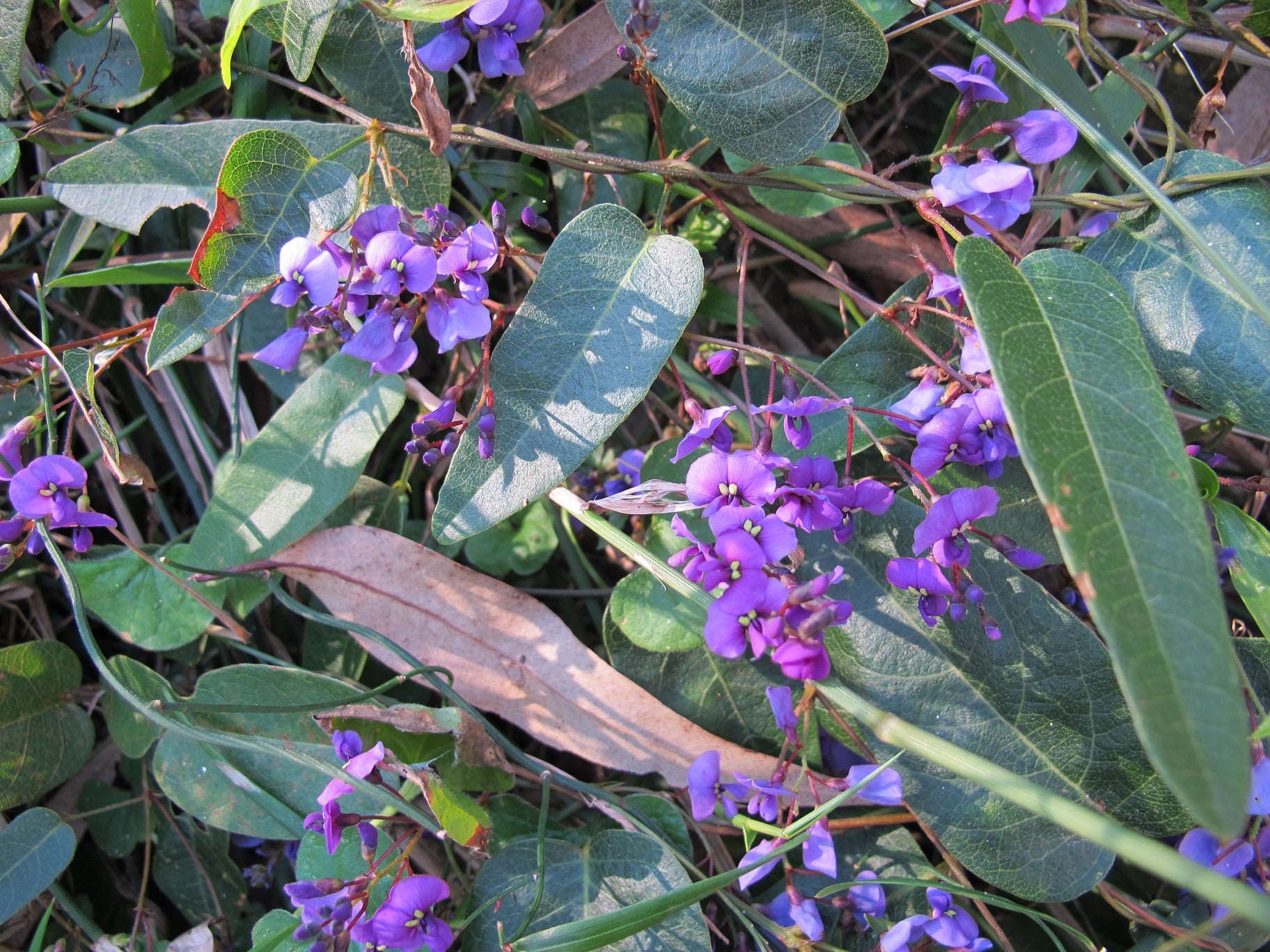
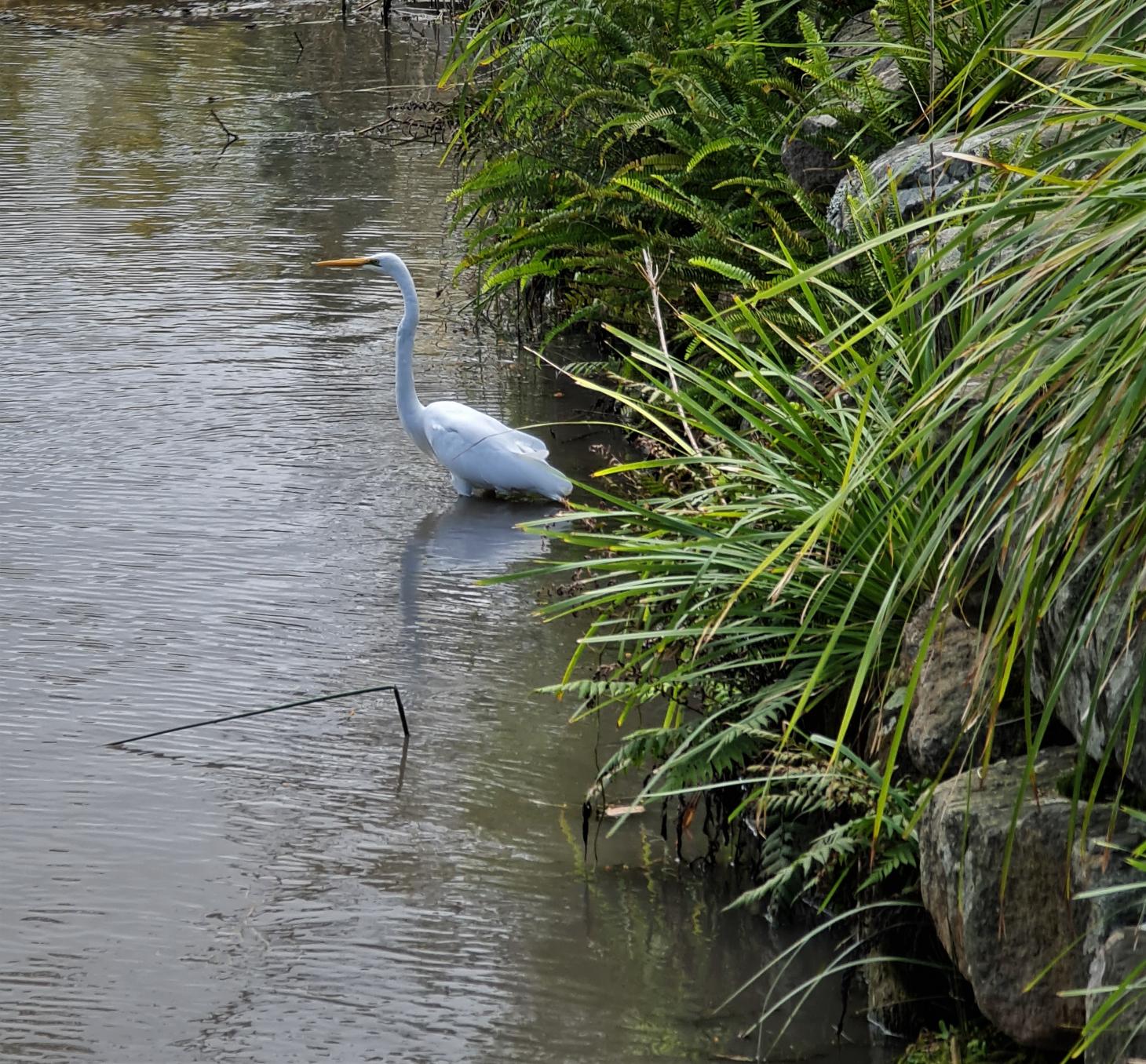
Aussie Backyard Bird Count 2021
Save the date – there’s only 1 MONTH TO GO until the 2021 Aussie Bird Count and we can’t wait!
The 2021 event will run from October 18‒24 during National Bird Week. Register as a counter today at: https://aussiebirdcount.org.au/
The Aussie Backyard Bird Count is one of Australia’s biggest citizen science events. This year is our eighth count, and we’re hoping it will be our biggest yet!
Join thousands of people around the country in exploring your backyard, local park or favourite outdoor space and help us learn more about the birds that live where people live.
Taking part in the Aussie Backyard Bird Count is a great way to connect with the birds in your backyard, no matter where your backyard happens to be. You can count in a suburban garden, a local park, a patch of forest, down by the beach, or the main street of town.
To take part, register on the website today, then during the count you can use the web form or the app to submit your counts. Just enter your location and get counting ‒ each count takes just 20 minutes!
Not only will you be contributing to BirdLife Australia's knowledge of Aussie birds, but there are also some incredible prizes on offer.
Head over to the Aussie Backyard Bird Count website to find out more.
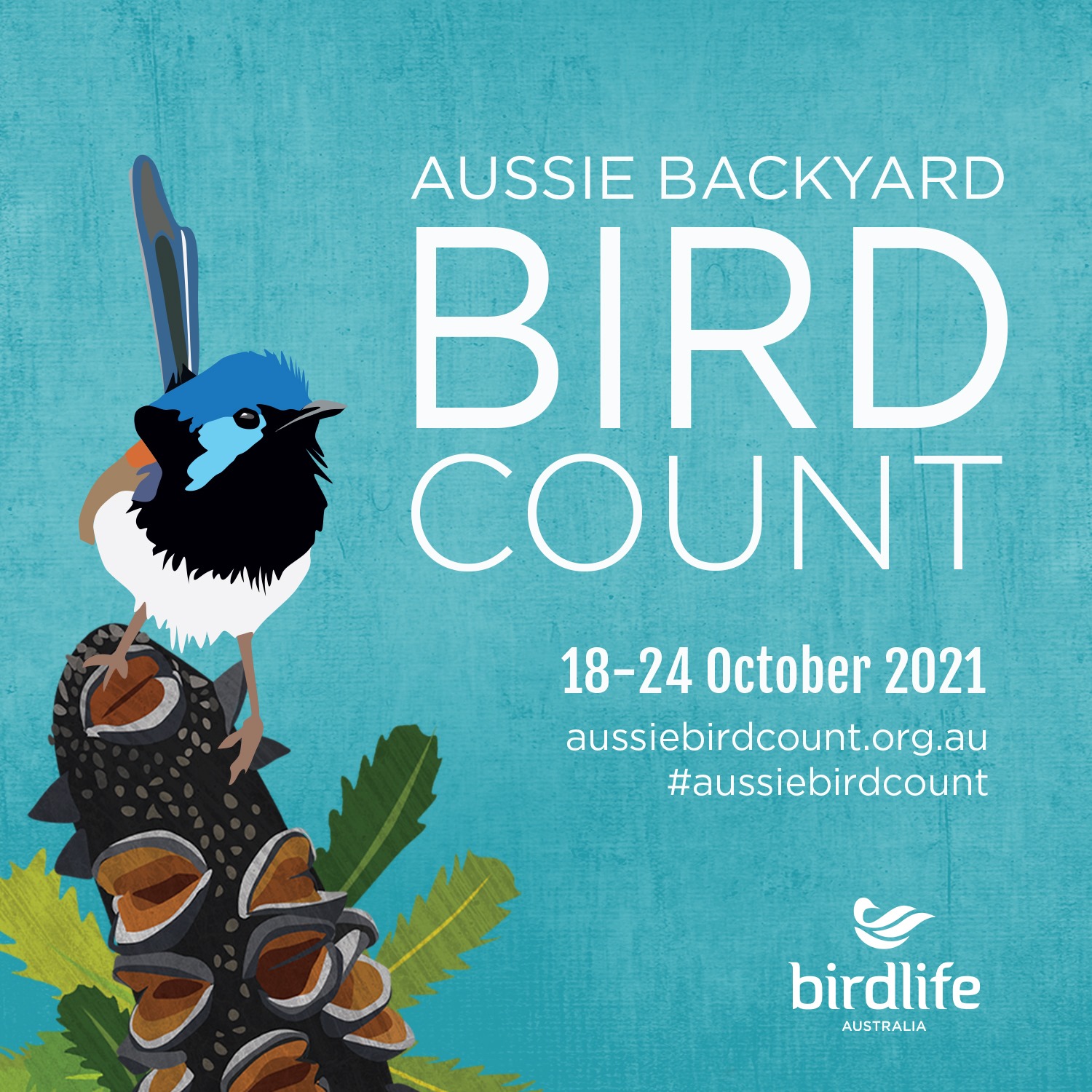
Migratory Bird Season
Baby Wildlife Season

Harry the ringtail possum. Sydney Wildlife photo
September Is Koala Month & Biodiversity Month
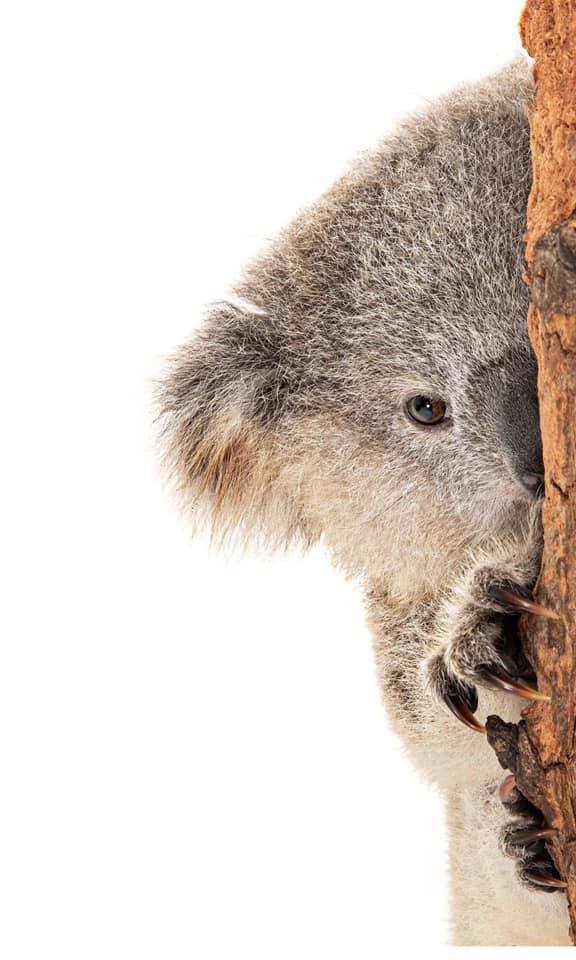
Cockatoo Preening
November 2021 Forum For Friends Of Narrabeen Lagoon Catchment: Fishing Bats And Water Rats (Rakali)
.jpg?timestamp=1631741816240)
.jpg?timestamp=1631741908384)
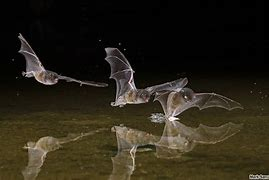
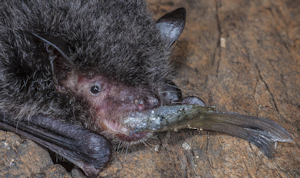
Managing Climate Risks To Assets And Services: New South Wales Auditor-General's Report - Performance Audit
- enhance the coordination of climate risk management across agencies
- implement climate risk management across their clusters.
- update information and strengthen education to agencies, and monitor progress
- review relevant land-use planning, development and building guidance
- deliver a climate change adaptation action plan for the state.
- strengthen climate risk-related guidance to agencies
- coordinate guidance on resilience in infrastructure planning
- review how climate risks have been assured in agencies’ asset management plans.
Smoke from the Black Summer fires created an algal bloom bigger than Australia in the Southern Ocean
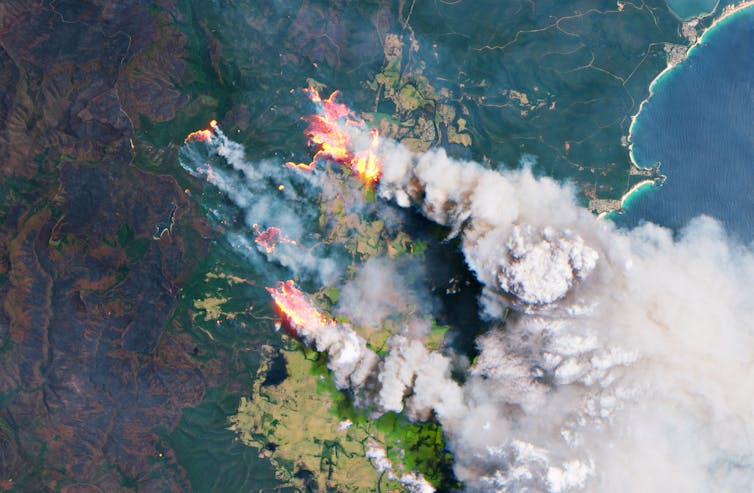
In 2019 and 2020, bushfires razed more than 18 million hectares of land in Australia. For weeks, smoke choked major cities, leading to almost 450 deaths, and even circumnavigated the southern hemisphere.
As the aerosols billowed across the oceans many thousands of kilometres away from the fires, microscopic marine algae called phytoplankton had an unexpected windfall: they received a boost of iron.
Our research, published today in Nature, found this caused phytoplankton concentrations to double between New Zealand and South America, until the bloom area became bigger than Australia. And it lasted for four months.
This enormous, unprecedented algal bloom could have profound implications for carbon dioxide levels in the atmosphere and for the marine ecosystem. But so far, the impact is still unclear.
Meanwhile, in another paper published alongside ours in Nature today, researchers from The Netherlands found the amount of carbon dioxide emitted by the fires that summer was more than double previous estimates.
Absorbing 680 Million Tonnes Of Carbon Dioxide
Iron fertilises phytoplankton and helps them grow, in the same way nutrients added in soil help vegetables grow. And like plants on land, phytoplankton photosynthesise — they absorb CO₂ as they grow and produce oxygen for fish and other marine creatures.
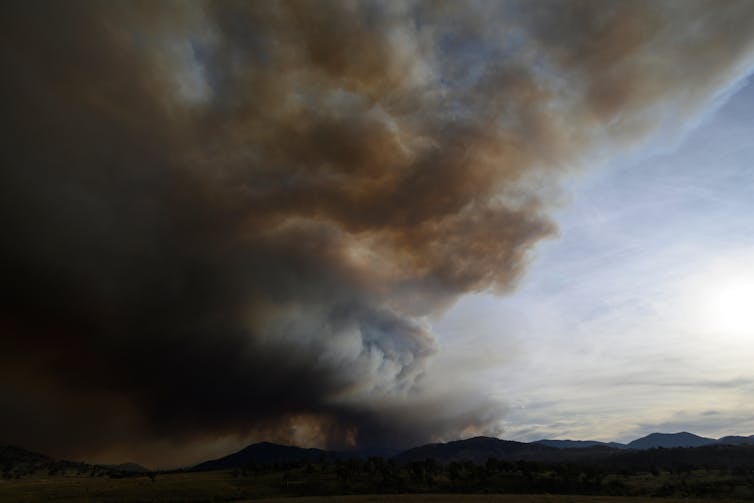
We used satellite data to estimate that for phytoplankton to grow as much as they did in the Southern Ocean, they would have absorbed 680 million tonnes of CO₂. This means the phytoplankton absorbed roughly the same amount of CO₂ as released by the bushfires, according to the latest estimates released today.
The Dutch researchers found the bushfires released 715 million tonnes of CO₂ (or ranging 517–867 million tonnes) between November 2019 and January 2020. This surpasses Australia’s normal annual fire and fossil fuel emissions by 80%.
To put this into perspective, Australia’s anthropogenic CO₂ emissions in 2019 were much less, at 520 million tonnes.
Phytoplankton Can Have Dramatic Effects On Climate
But that doesn’t mean the phytoplankton growth absorbed the bushfire’s CO₂ emissions permanently. Whether phytoplankton growth extracts and keeps CO₂ from the atmosphere depends on their fate.
If they sink to the deep ocean, then this represents a carbon sink for decades or even centuries — or even longer if phytoplankton are stored in ocean sediments.
But if they’re mostly eaten and decomposed near the ocean’s surface, then all that CO₂ they consumed comes straight back out, with no net effect on the carbon balance in the atmosphere.
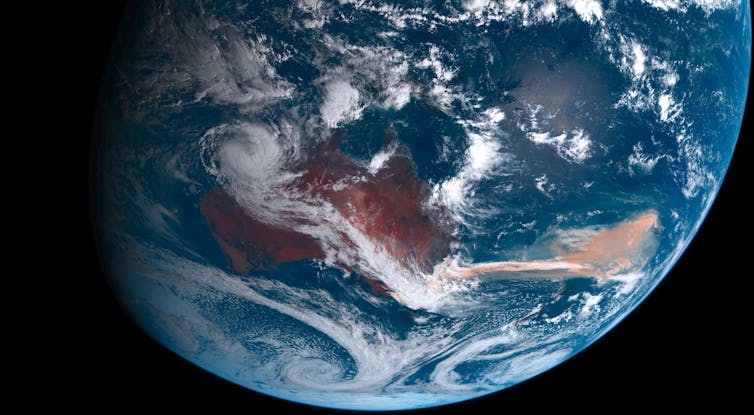
In fact, phytoplankton have very likely played a role on millennial time scales in keeping atmospheric CO₂ concentrations down, and can affect the global climate in the long term.
For example, a 2014 study suggests iron-containing dust billowing over the Southern Ocean caused increased phytoplankton productivity, which contributed to reducing atmospheric CO₂ by about 100 parts per million. And this helped transition the planet to ice ages.
Read more: Inside the world of tiny phytoplankton – microscopic algae that provide most of our oxygen
Phytoplankton blooms can also have a big impact on the marine ecosystem as they make excellent food for some marine creatures.
For example, more phytoplankton means more food for zooplankton that feed on phytoplankton, with effects up the food chain. It’s also worth noting this huge bloom occurred at a time of year when phytoplankton are usually in decline in this part of the ocean.
But whether there were any long-lasting effects from the bushfire-fuelled phytoplankton on the climate or ecosystem is unclear, because we still don’t know where they ended up.
Using Revolutionary Data
The link between fire aerosols and the increase in phytoplankton demonstrated in our study is particularly relevant given the intense fire activity around the globe.
Droughts and warming under global climate change are expected to increase the frequency and intensity of wildfires, and the impacts to land-based ecosystems, such as habitat loss and air pollution, will be dramatic. But as we now know, wildfires can also affect marine life thousands of kilometres away from land.
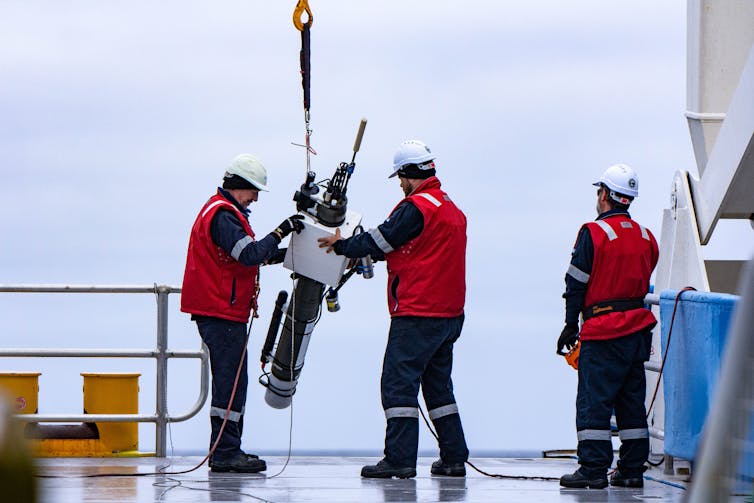
Previous models have predicted the iron-fertilising effect of bushfire aerosols, but this is the first time we’ve observed and demonstrated the connection at a large-scale.
Our study is mainly based on satellite data and observations from robotic floats that roam the oceans and collect data autonomously. These robotic floats are revolutionising our understanding of chemical cycling, oxygen variability and ocean acidification.
During the bushfire period, our smoke tracers reached concentrations at least 300% higher than what had ever been observed in the 22-year satellite record for the region.
Interestingly, you wouldn’t be able to observe the resulting phytoplankton growth in a true-colour satellite image. We instead used more sensitive ocean colour sensors on satellites to estimate phytoplankton concentrations.
Read more: Tiny plankton drive processes in the ocean that capture twice as much carbon as scientists thought
So What’s Next?
Of course, we need more research to determine the fate of the phytoplankton. But we also need more research to better predict when and where aerosol deposition (such as bushfire smoke) will boost phytoplankton growth.
For example, the Tasman Sea — between Australia and New Zealand — showed only mildly higher phytoplankton concentrations during the bushfire period, even though the smoke cloud was strongest there.
Was this because nutrients other than iron were lacking, or because there was less deposition? Or perhaps because the smoke didn’t stick around for as long?
Whatever the reason, it’s clear this is only the beginning of exciting new lines of research that link forests, wildfires, phytoplankton growth and Earth’s climate.
Christina Schallenberg, Research Fellow, University of Tasmania; Jakob Weis, Ph.D. student, University of Tasmania; Joan Llort, Oceanógrafo , Barcelona Supercomputing Center-Centro Nacional de Supercomputación (BSC-CNS); Peter Strutton, Professor, Institute for Marine and Antarctic Studies, University of Tasmania, and Weiyi Tang, Postdoc in Biogeochemistry, Princeton University
This article is republished from The Conversation under a Creative Commons license. Read the original article.
Rural Boundary Clearing Code Opens Up More Bushland For Destruction
Destroying vegetation along fences and roads could worsen our extinction crisis — yet the NSW government just allowed it
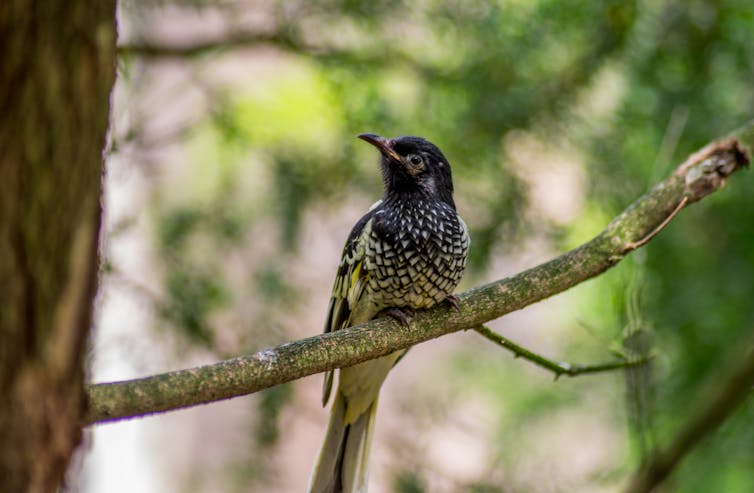
What do koalas, barking owls, greater gliders, southern rainbow skinks, native bees, and regent honeyeaters all have in common? Like many native species, they can all be found in vegetation along fences and roadsides outside formal conservation areas.
They may be relatively small, but these patches and strips conserve critical remnant habitat and have disproportionate conservation value worldwide. They represent the last vestiges of once-expansive tracts of woodland and forests, long lost to the chainsaw or plough.
And yet, the NSW government last week made it legal for rural landholders to clear vegetation within 25 metres of their property boundaries, without approval. This radical measure is proposed to protect people and properties from fires, despite the lack of such an explicit recommendation from federal and state-based inquiries into the devastating 2019-20 bushfires.
This is poor environmental policy that lacks apparent consideration or justification of its potentially substantial ecological costs. It also gravely undermines the NSW government’s recent announcement of a plan for “zero extinction” within the state’s national parks, as the success of protected reserves for conservation is greatly enhanced by connection with surrounding “off-reserve” habitat.
Small Breaks In Habitat Can Have Big Impacts
A 25m firebreak might sound innocuous, but when multiplied by the length of property boundaries in NSW, the scale of potential clearing and impacts is alarming, and could run into the hundreds of thousands of kilometres.
Some plants, animals and fungi live in these strips of vegetation permanently. Others use them to travel between larger habitat patches. And for migratory species, the vegetation provides crucial refuelling stops on long distance journeys.
For example, the roadside area in Victoria’s Strathbogie Ranges shown below is home to nine species of tree-dwelling native mammals: two species of brushtail possums, three species of gliders (including threatened greater gliders), common ringtail possums, koalas, brush-tailed phascogales, and agile antenchinus (small marsupials).
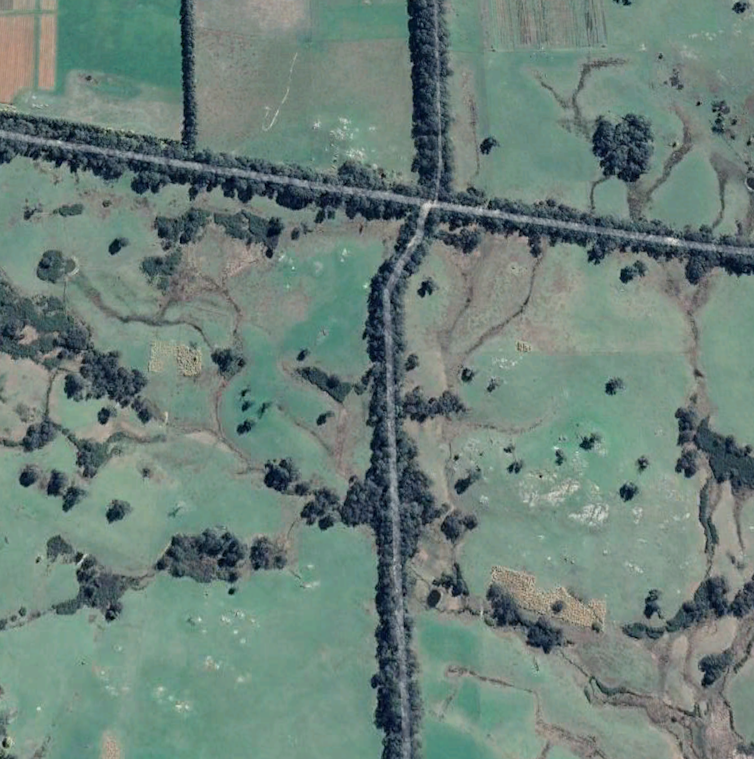
Many of these species depend on tree hollows that can take a hundred years to form. If destroyed, they are effectively irreplaceable.
Creating breaks in largely continuous vegetation, or further fragmenting already disjointed vegetation, will not only directly destroy habitat, but can severely lower the quality of adjoining habitat.
This is because firebreaks of 25m (or 50m where neighbouring landholders both clear) could prevent the movement and dispersal of many plant and animal species, including critical pollinators such as native bees.
An entire suite of woodland birds, including the critically endangered regent honeyeater, are threatened because they depend on thin strips of vegetation communities that often occur inside fence-lines on private land.
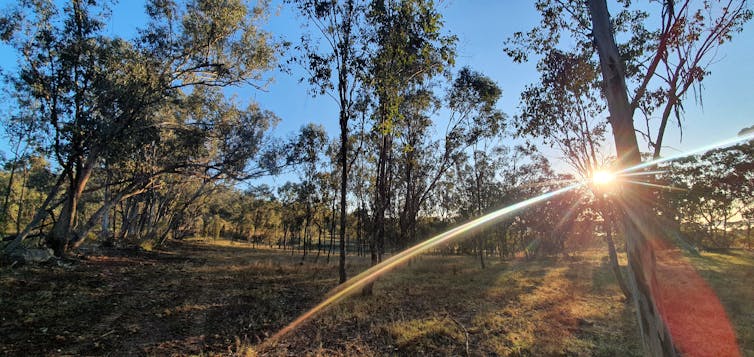
For instance, scientific monitoring has shown five pairs of regent honeyeaters (50% of all birds located so far this season) are nesting or foraging within 25m of a single fence-line in the upper Hunter Valley. This highlights just how big an impact the loss of one small, private location could have on a species already on the brink of extinction.
Read more: Only the lonely: an endangered bird is forgetting its song as the species dies out
But it’s not just regent honeyeaters. The management plan for the vulnerable glossy black cockatoo makes specific recommendation that vegetation corridors be maintained, as they’re essential for the cockatoos to travel between suitable large patches.
Native bee conservation also relies on the protection of remnant habitat adjoining fields. Continued removal of habitat on private land will hinder chances of conserving these species.
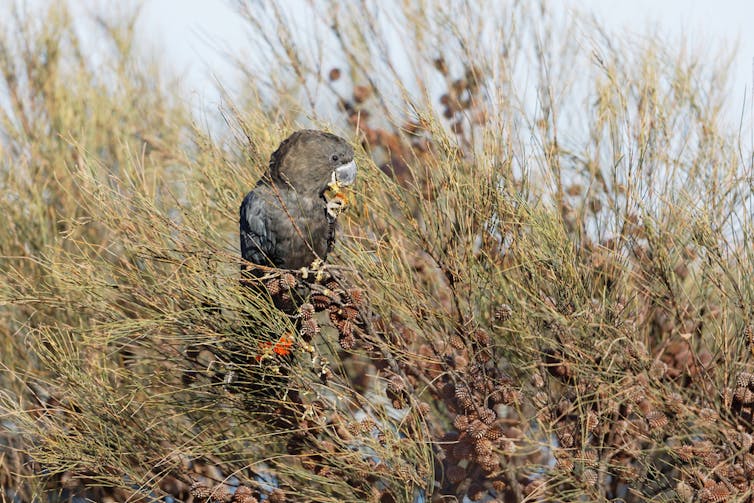
Disastrous Clearing Laws
The new clearing code does have some regulations in place, albeit meagre. For example, on the Rural Fire Service website, it says the code allows “clearing only in identified areas, such as areas which are zoned as Rural, and which are considered bush fire prone”. And according to the RFS boundary clearing tool landowners aren’t allowed to clear vegetation near watercourses (riparian vegetation).
Even before introducing this new code, NSW’s clearing laws were an environmental disaster. In 2019, The NSW Audit Office found:
clearing of native vegetation on rural land is not effectively regulated [and] action is rarely taken against landholders who unlawfully clear native vegetation.
The data back this up. In 2019, over 54,500 hectares were cleared in NSW. Of this, 74% was “unexplained”, which means the clearing was either lawful (but didn’t require state government approval), unlawful or not fully compliant with approvals.
Landholders need to show they’ve complied with clearing laws only after they’ve already cleared the land. But this is too late for wildlife, including plant species, many of which are threatened.
Read more: The 50 beautiful Australian plants at greatest risk of extinction — and how to save them
Landholders follow self-assessable codes, but problems with these policies have been identified time and time again — they cumulatively allow a huge amount of clearing, and compliance and enforcement are ineffective.
We also know, thanks to various case studies, the policy of “offsetting” environmental damage by improving biodiversity elsewhere doesn’t work.
So, could the federal environment and biodiversity protection law step in if habitat clearing gets out of hand? Probably not. The problem is these 25m strips are unlikely to be referred in the first place, or be considered a “significant impact” to trigger the federal law.
The Code Should Be Amended
Nobody disputes the need to keep people and their assets safe against the risks of fire. The code should be amended to ensure clearing is only permitted where a genuinely clear and measurable fire risk reduction is demonstrated.
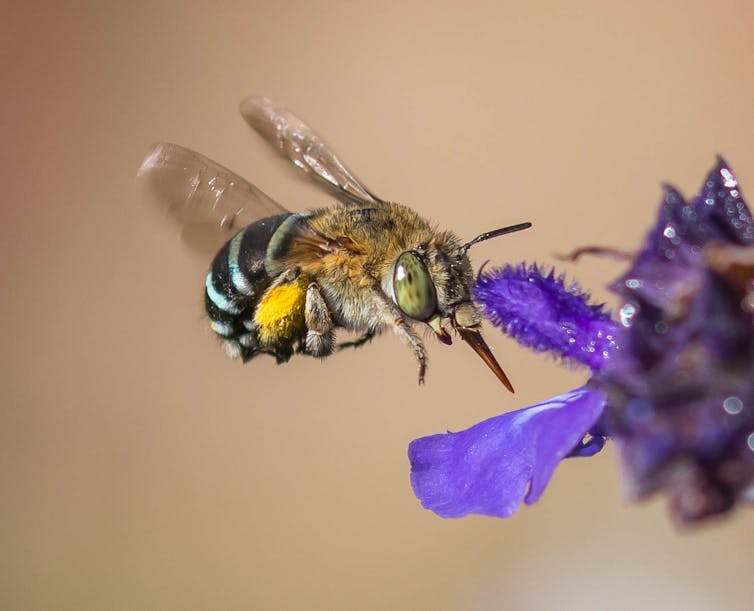
Granting permission to clear considerable amounts of native vegetation, hundreds if not thousands of metres away from homes and key infrastructure in large properties is hard to reconcile, and it seems that no attempt has been made to properly justify this legislation.
We should expect that a comprehensive assessment of the likely impacts of a significant change like this would inform public debate prior to decisions being made. But to our knowledge, no one has analysed, or at least revealed, how much land this rule change will affect, nor exactly what vegetation types and wildlife will likely be most affected.
A potentially devastating environmental precedent is being set, if other regions of Australia were to follow suit. The environment and Australians deserve better.
Read more: 'Existential threat to our survival': see the 19 Australian ecosystems already collapsing ![]()
Euan Ritchie, Professor in Wildlife Ecology and Conservation, Centre for Integrative Ecology, School of Life & Environmental Sciences, Deakin University; Ben Moore, Senior Lecturer in Ecology, Hawkesbury Institute for the Environment, Western Sydney University; Jen Martin, Leader, Science Communication Teaching Program, The University of Melbourne; Mark Hall, Postdoctoral research fellow, Hawkesbury Institute for the Environment, Western Sydney University; Megan C Evans, Lecturer and ARC DECRA Fellow, UNSW, and Ross Crates, Postdoctoral fellow, Australian National University
This article is republished from The Conversation under a Creative Commons license. Read the original article.
Zero Extinctions Target Set For NSW National Parks
- The AIS initiative is a key pillar of the National Parks Threatened Species Framework, which will align NPWS with the global biodiversity agenda and position the agency as a world leader in threatened species conservation.
- AIS declarations for land containing important threatened species habitat, supported by Conservation Action Plans will ensure NPWS:
- has identified the most important on-park habitat for threatened species, has up-to-date data on populations in these areas, and can share this information with others, including firefighting agencies and conservation partners
- has action plans in place to reduce threats and improve the conservation status of threatened species in priority locations
- is regularly monitoring the health of these populations and publicly reporting outcomes.
- Other measures being implemented to protect threatened species on national parks include:
- Acquisition of key threatened species habitat for addition to the national park estate
- The establishment of a network of feral predator-free areas to support the return of more than 25 locally extinct species
- Delivery of the largest feral animal control program in national park history
- Establishment of a dedicated ecological risk unit to ensure threatened species are considered in new fire plans
- Rolling out a world class ecological health framework across national parks
- In total 66 plant species (Including the previously declared Wollemi Pine) and 27 animal species including 13 mammals, four birds, seven frogs and three reptiles
- 221 AIS sites across 110 national parks totalling 301,843 hectares (3.89% of the National Parks estate
- 92 new species of plants and animals to attain AIS status, including:
- Brush-tailed Rock-wallaby: 7 sites including a highly endangered population in the Warrumbungles, where the population is now < 10 individuals
- Koala: 15 of the most important koala strongholds on national parks such as Lake Innes, Port Macquarie and Upper Nepean SCA, south west of Sydney.
- Dwarf Mountain Pine: Less than 800 plants remain in the spray zones along cliff faces between Wentworth Falls and Katoomba in the upper Blue Mountains.
- Nightcap Oak: a small population of around 125 adult plants found only on the Nightcap Range, north of Lismore
Ocean Conservationists Welcome Australia’s Support For Global Plastics Treaty
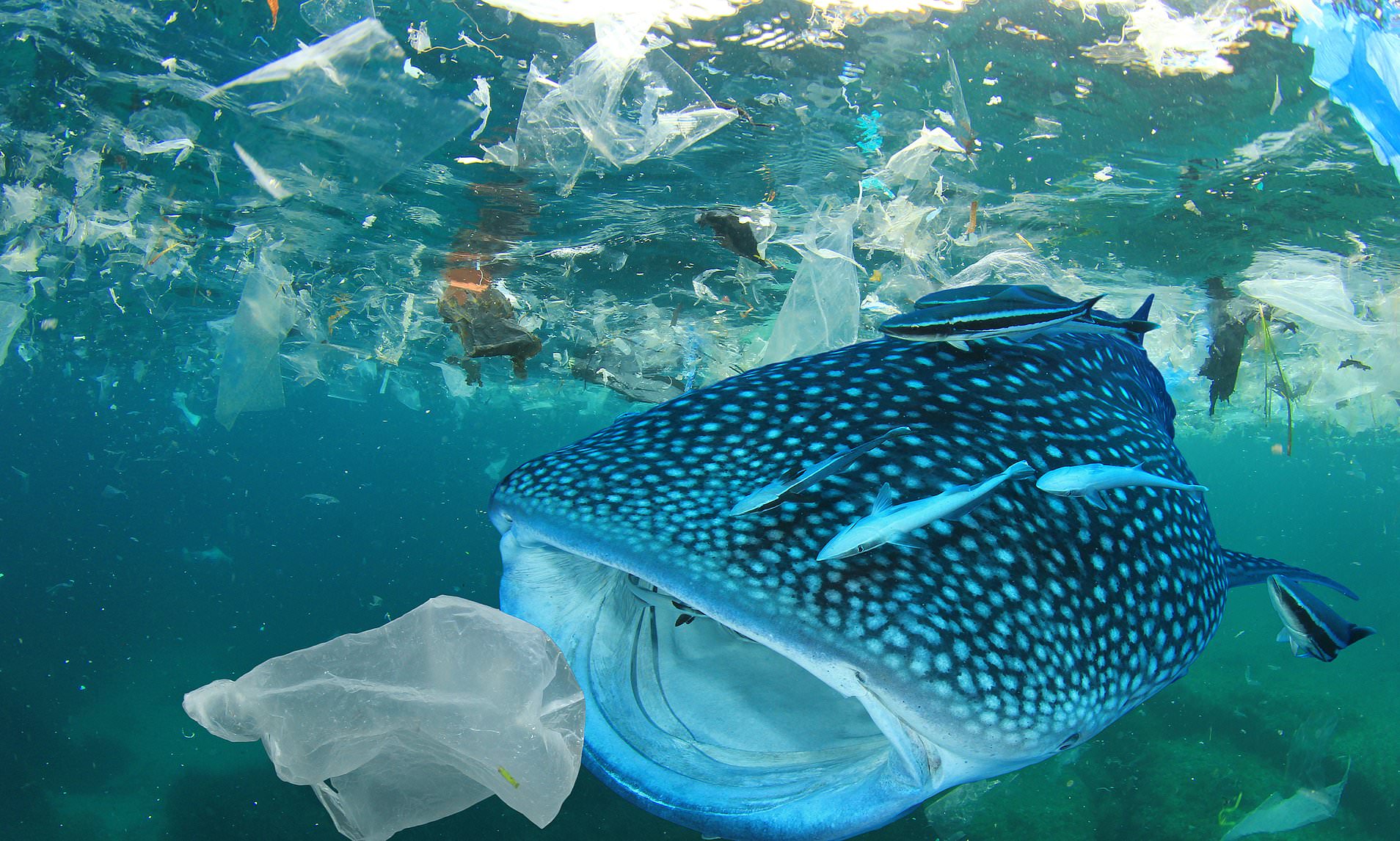
What Is The 'Global Plastics Treaty'?
- There is no clear global ambition or target
- No common obligation for nations to develop action plans
- No agreed standards for monitoring and reporting of plastics discharge into the sea
- No standardised review of the effectiveness of different pollution reduction measures
- No specialised scientific body with a mandate to assess the global problem and give guidance to decision makers
- Global targets with deadlines for reducing plastic and cleaning up our oceans, with all nations working together to eliminate unnecessary or dangerous plastics and ensure all plastic is reused, recycled or composted in practice. This could include things like an international ban on dumping plastic in rivers and waterways, and global bans on plastics like bags and straws that are a high risk for ocean wildlife.
- Monitoring and reporting on plastics in the natural environment, with nations required to report on their efforts to cut plastic. Advocates are also calling for a specialised international scientific body with a mandate to investigate and track the scale and sources of plastic pollution, providing world class scientific knowledge for effective policy making.
- Financial and technical support, with a dedicated global body providing financial support and technical expertise for countries with limited capacity. This would be critical for helping badly affected nations at the edges of the worst plastic hotspots like the Great Pacific Garbage patch, many of whom lack the infrastructure and resources to deal with the waves of plastic washing up on their shores.
- Pew Charitable Trusts and Systemiq. (2020). Breaking the Plastic Wave.
Catch Alert Drumlines Set To Be Trialled On Queensland Beaches Will Reduce Marine Wildlife Deaths Conservationists Say
Western Sydney Breathes A Little Easier Thanks To Waste Incinerator Decisions
Bylong Valley Spared From Coal Mining Again
- Bylong Community Wins Again as Coal Mine Appeal is Dismissed, EDO, 14-9-21
- Huge legal win sees greenfield Bylong Coal Project refusal upheld, EDO, 18-12-2020
NSW Government Urged To Give Bylong Back To Farmers Following KEPCO’s Latest Legal Loss
NT 'Environment' Minister Lawler Signals Approval Of Fracking Plan
Consultation Opens For Mining Exploration Program
Public Consultation Opens For Greenhouse Gas Storage Areas
- Bonaparte Basin
- Browse Basin
- Northern Carnarvon Basin.
Minister Pitt States Coal To Continue Help Powering Australian Economy
Pitt States Will Continue Funding For Fracking Despite Court Challenge To Fracked Gas Cash Splash
Beetaloo Cooperative Drilling Program Will Continue
Tasmania’s salmon industry detonates underwater bombs to scare away seals – but at what cost?

Australians consume a lot of salmon – much of it farmed in Tasmania. But as Richard Flanagan’s new book Toxic shows, concern about the industry’s environmental damage is growing.
With the industry set to double in size by 2030, one dubious industry practice should be intensely scrutinised – the use of so-called “cracker bombs” or seal bombs.
The A$1 billion industry uses the technique to deter seals and protect fish farming operations. Cracker bombs are underwater explosive devices that emit sharp, extremely loud noise impulses. Combined, Tasmania’s three major salmon farm operators have detonated at least 77,000 crackers since 2018.
The industry says the deterrent is necessary, but international research shows the devices pose a significant threat to some marine life. Unless the salmon industry is more strictly controlled, native species will likely be killed or injured as the industry expands.
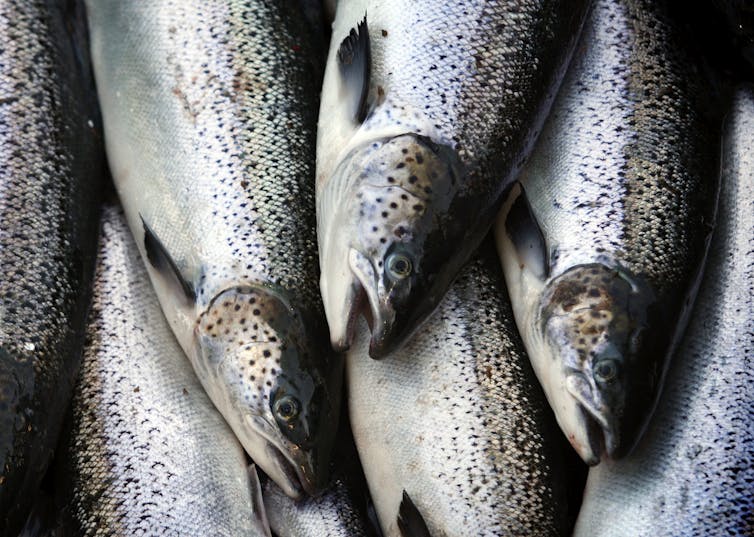
Protecting A Lucrative Industry
Marine farming has been growing rapidly in Tasmania since the 1990s, and Atlantic salmon is Tasmania’s most lucrative fishery‑related industry. The salmon industry comprises three major producers: Huon Aquaculture, Tassal and Petuna.
These companies go to great effort to protect their operations from fur seals, which are protected in Australia with an exemption for the salmon industry.
Seals may attack fish pens in search of food and injure salmon farm divers, though known incidents of harm to divers are extremely rare.
The industry uses a number of seal deterrent devices, the use of which is approved by the government. They include:
lead-filled projectiles known as “beanbags”, which are fired from a gun
sedation darts fired from a gun
explosive charges or “crackers” thrown into the water which detonate under the surface.
In June this year, the ABC reported on government documents showing the three major salmon producers had detonated more than 77,000 crackers since 2018. The documents showed how various seal deterrent methods had led to maiming, death and seal injuries resulting in euthanasia. Blunt-force trauma was a factor in half the reported seal deaths.
A response to this article by the salmon industry can be found below. The industry has previoulsy defended the use of cracker bombs, saying it has a responsibility to protect workers. It says the increased use of seal-proof infrastructure means the use of seal deterrents is declining. If this is true, it’s not yet strongly reflected in the data.
Read more: Here's the seafood Australians eat (and what we should be eating)
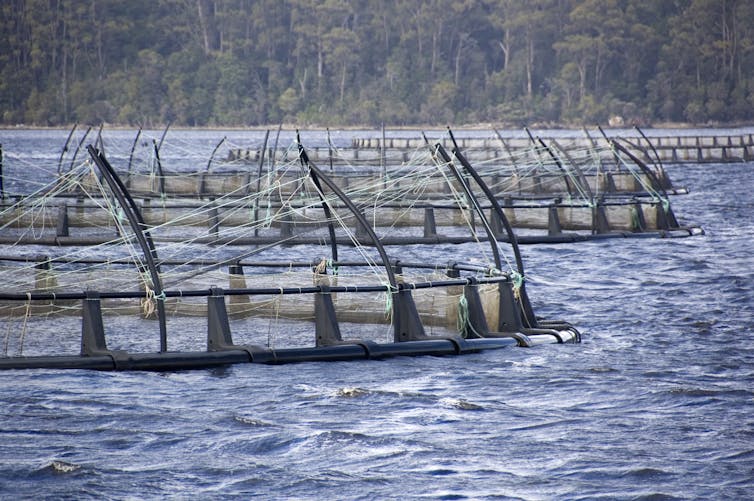
Piercing The Ocean Silence
Given the prevalence of seal bomb use by the salmon industry, it’s worth reviewing the evidence on how they affect seals and other marine life.
A study on the use of the devices in California showed they can cause horrific injuries to seals. The damage includes trauma to bones, soft tissue burns and prolapsed eye balls, as well as death.
And research suggests damage to marine life extends far beyond seals. For example, the devices can disturb porpoises which rely on echolocation to find food, avoid predators and navigate the ocean. Porpoises emit clicks and squeaks – sound which travels through the water and bounces off objects. In 2018, a study found seal bombs could disturb harbour porpoises in California at least 64 kilometres from the detonation site.
There is also a body of research showing how similar types of industrial noise affect marine life. A study in South Africa in 2017 showed how during seismic surveys in search of oil or gas, which produce intense ocean noise, penguins raising chicks often avoided their preferred foraging areas. Whales and fish have also shown similar avoidance behaviour.
The study showed underwater blasts can also kill and injure seabirds such as penguins. And there may be implications from leaving penguin nests unattended and vulnerable to predators, and leaving chicks hungry longer.
Research also shows underwater explosions damage to fish. One study on caged fish reported profound trauma to their ears, including blistering, holes and other damage. Another study cited official reports of dead fish in the vicinity of seal bomb explosions.

Shining A Light
Clearly, more scientific research is needed into how seal bombs affect marine life in the oceans off Tasmania. And regulators should impose far stricter limits on the salmon industry’s use of seal bombs – a call echoed by Tasmania’s Salmon Reform Alliance.
All this is unfolding as federal environment laws fail to protect Australian plant and animal species, including marine wildlife.
And the laws in Tasmania are far from perfect. In 2017, Tasmania’s Finfish Farming Environmental Regulation Act introduced opportunities for better oversight of commercial fisheries. However, as the Environmental Defenders Office (EDO) has noted, the director of Tasmania’s Environment Protection Authority can decide on license applications by salmon farms without the development necessarily undergoing a full environmental assessment.
Tasmania’s Marine Farming Planning Act covers salmon farm locations and leases. As the EDO has noted, the public is not notified of some key decisions under the law and has very limited public rights of appeal.
Two relevant public inquiries are underway – a federal inquiry into aquaculture expansion and a Tasmanian parliamentary probe into fin-fish sustainability. Both have heard evidence from community stakeholders, such as the Tasmanian Alliance for Marine Protection and the Tasmanian Conservation Trust, that the Tasmanian salmon industry lacks transparency and provides insufficient opportunities for public input into environmental governance.
The Tasmanian government has thrown its support behind rapid expansion of the salmon industry. But it’s essential that the industry is more tightly regulated, and far more accountable for any environmental damage it creates.
Read more: Why Indigenous knowledge should be an essential part of how we govern the world's oceans
In a statement in response to this article, the Tasmanian Salmonid Growers Association, which represents the three producers named above, said:
Around $500 million has been spent on innovative pens by the industry. These pens are designed to minimise risks to wildlife as well as to fish stocks and the employees. We believe that farms should be designed to minimise the threat of seals, but we also understand that non-lethal deterrents are a part of the measures approved by the government for the individual member companies to use. If these deterrents are used it is under strict guidelines, sparingly, and in emergency situations when staff are threatened by these animals, which can be very aggressive.
Tasmania has a strong, highly regulated, longstanding salmon industry of which we should all be proud. The salmon industry will continue its track record of operating at world’s best practice now and into future. Our local people have been working in regional communities for more than 30 years, to bring healthy, nutritious salmon to Australian dinner plates, through innovation and determination.
Benjamin J. Richardson, Professor of Environmental Law, University of Tasmania
This article is republished from The Conversation under a Creative Commons license. Read the original article.
How much will our oceans warm and cause sea levels to rise this century? We’ve just improved our estimate
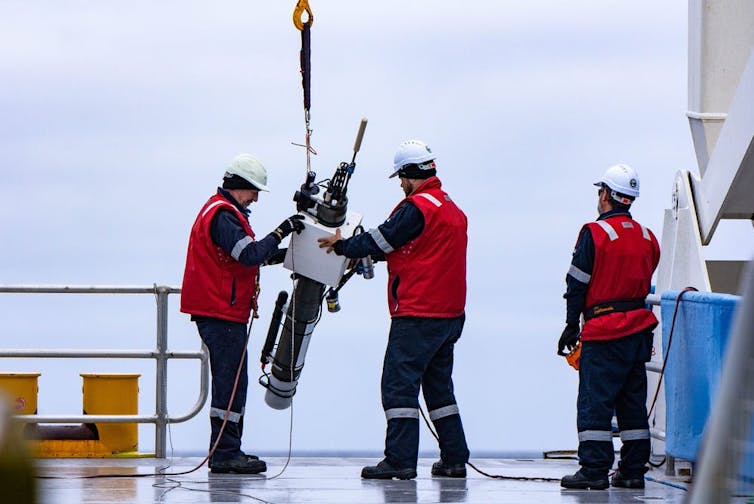
Knowing how much sea levels are likely to rise during this century is vital to our understanding of future climate change, but previous estimates have generated wide ranges of uncertainty. In our research, published today in Nature Climate Change, we provide an improved estimate of how much our oceans are going to warm and its contribution to sea level rise, with the help of 15 years’ worth of measurements collected by a global array of autonomous underwater sampling floats.
Our analysis shows that without dramatic reductions in greenhouse gas emissions, by the end of this century the upper 2,000 metres of the ocean is likely to warm by 11-15 times the amount of warming observed during 2005-19. Water expands as it gets warmer, so this warming will cause sea levels to rise by 17-26 centimetres. This is about one-third of the total projected rise, alongside contributions from deep ocean warming, and melting of glaciers and polar ice sheets.
Ocean warming is a direct consequence of rising greenhouse gas concentrations in the atmosphere as a result of our burning of fossil fuels. This results in an imbalance between the energy arriving from the Sun, and the energy radiated out into space. About 90% of the excess heat energy in the climate system over the past 50 years is stored in the ocean, and only about 1% in the warming atmosphere.
Warming oceans cause sea levels to rise, both directly via heat expansion, and indirectly through melting of ice shelves. Warming oceans also affect marine ecosystems, for example through coral bleaching, and play a role in weather events such as the formation of tropical cyclones.
Systematic observations of ocean temperatures began in the 19th century, but it was only in the second half of the 20th century that enough observations were made to measure ocean heat content consistently around the globe.
Since the 1970s these observations indicate an increase in ocean heat content. But these measurements have significant uncertainties because the observations have been relatively sparse, particularly in the southern hemisphere and at depths below 700m.
To improve this situation, the Argo project has deployed a fleet of autonomous profiling floats to collect data from around the world. Since the early 2000s, they have measured temperatures in the upper 2,000m of the oceans, and sent the data via satellite to analysis centres around the world.
These data are of uniform high quality and cover the vast majority of the open oceans. As a result, we have been able to calculate a much better estimate of the amount of heat accumulating in the world’s oceans.
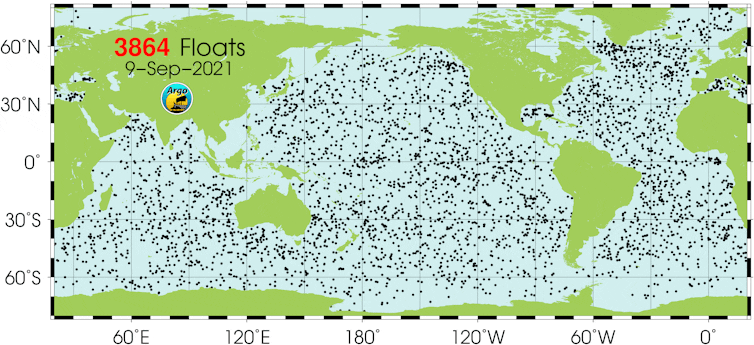
The global ocean heat content continued to increase unabated during the temporary slowdown in global surface warming in the beginning of this century. This is because ocean warming is less affected than surface warming by natural yearly fluctuations in climate.
Read more: Ocean depths heating steadily despite global warming 'pause'
Current Observations, Future Warming
To estimate future ocean warming, we need to take the Argo observations as a basis and then use climate models to project them into the future. But to do that, we need to know which models are in closest agreement with new, more accurate direct measurements of ocean heat provided by the Argo data.
The latest climate models, used in last month’s landmark report by the Intergovernmental Panel on Climate Change, all show ocean warming over the period of available Argo observations, and they project that warming will continue in the future, albeit with a wide range of uncertainties.
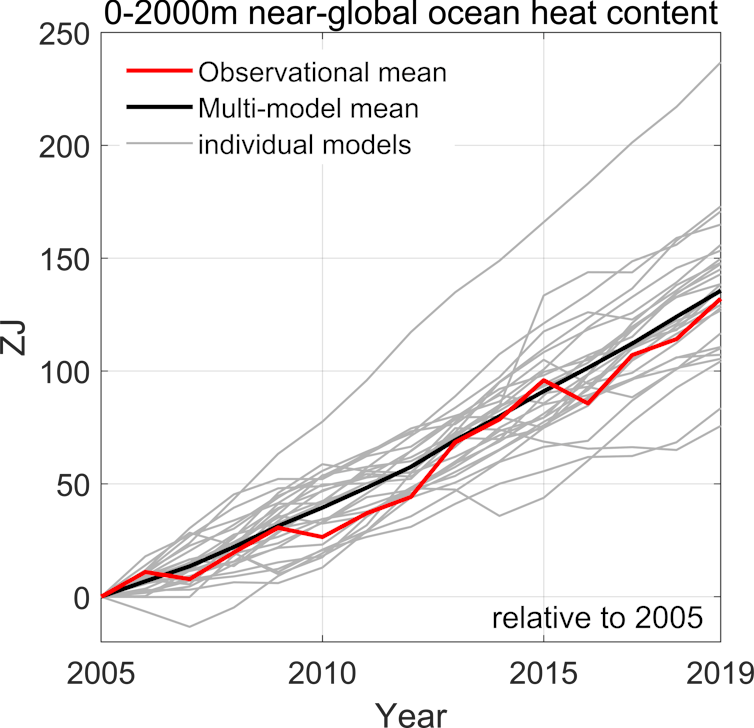
Read more: Explainer: what is climate sensitivity?
By comparing the Argo temperature data for 2005-19 with the simulations generated by models for that period, we used a statistical approach called “emergent constraint” to reduce uncertainties in model future projections, based on information about the ocean warming we know has already occurred. These constrained projections then provided an improved estimate of how much heat energy will accumulate in the oceans by the end of the century.
By 2081–2100, under a scenario in which global greenhouse emissions continue on their current high trajectory, we found the upper 2,000m of the ocean is likely to warm by 11-15 times the amount of warming observed during 2005-19. This corresponds to 17–26cm of sea level rise from ocean thermal expansion.
Climate models can also make predictions based on a range of different future greenhouse gas emissions. Strong emissions reductions, consistent with bringing surface global warming to within about 2℃ of pre-industrial temperatures, would reduce the projected warming in the upper 2,000m of the ocean by about half — that is, between five and nine times the ocean warming already seen in 2005-19.
This would equate to 8-14cm of sea level rise due to thermal expansion. Of course, reducing emissions so as to hit the more ambitious Paris target of 1.5℃ surface warming would reduce these impacts even further.
Other Factors Linked To Sea Levels
There are several other factors that will also drive up sea levels, besides the heat influx into the upper oceans investigated by our research. There is also warming of the deep ocean below 2,000m, which is still under-sampled in the current observing system, as well as the effects of melting from glaciers and polar ice sheets.
This indicates that even with strong policy action to reduce greenhouse gas emissions, the oceans will continue to warm and sea levels will continue to rise well after surface warming is stabilised, but at a much reduced rate, making it easier to adapt to the remaining changes. Cutting greenhouse gas emissions earlier rather than later will be more effective at slowing ocean warming and sea level rise.
Read more: If we stopped emitting greenhouse gases right now, would we stop climate change?
Our improved projection is founded on a network of ocean observations that are far more extensive and reliable than anything available before. Sustaining the ocean observing system into the future, and extending it to the deep ocean and to areas not covered by the present Argo program, will allow us to make more reliable climate projections in the future.![]()
Kewei Lyu, Postdoctoral Researcher in Ocean and Climate, CSIRO; John Church, Chair Professor, Climate Change Research Centre, UNSW, and Xuebin Zhang, Principal Research Scientist, CSIRO
This article is republished from The Conversation under a Creative Commons license. Read the original article.
‘Bloody fool!’: why Ripper the musk duck, and many other talkative Aussie birds, are exciting biologists
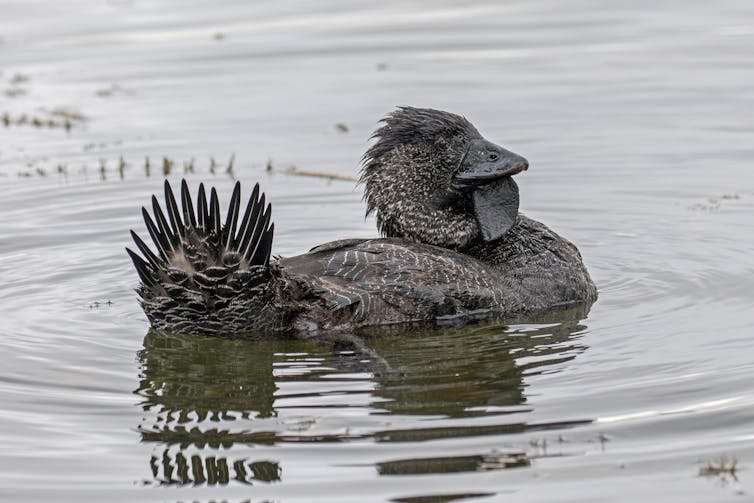
Recently, two native Australian birds have stolen the limelight with their impressive vocal imitations.
A superb lyrebird called Echo at Sydney’s Taronga Zoo has produced a painfully realistic vocal rendition of a human baby crying. Lyrebirds are already world-famous for their astonishingly accurate vocal mimicry, but these new recordings show their abilities can still surprise.
Then a new paper announced the arrival of an unexpected newcomer to Australia’s vocal imitation scene. A male musk duck (Biziura lobata) named Ripper was recorded imitating two stereotypical Australian sounds: a loudly shutting gate and a person exclaiming “you bloody fool!”.
The gate sound, at least, proved a hit with one of Ripper’s male colleagues who also ended up mimicking the sound. Excitingly, these recordings — originally from the 1980s and dug out from archives — provide the first material evidence of any duck species copying a sound in its environment, disrupting current understandings of the evolution of vocal learning in birds.
So what’s the big fuss about crying and swearing birds?
Why Musk Ducks Are Odd
Vocal production learning is a highly specialised trait that’s rare among animals. It requires flexible and sophisticated control over vocal production, and can be associated with enlarged regions of the brain relative to non-vocal learners.
For a long time, the only other animals known to possess similar vocal learning abilities to humans were parrots and male songbirds. But today, the musk duck joins a broad, but relatively small, list of non-human animals capable of vocal learning, including some bats, elephants, dolphins, whales and seals. Belatedly, we can now add female songbirds to the list of vocal production learners.
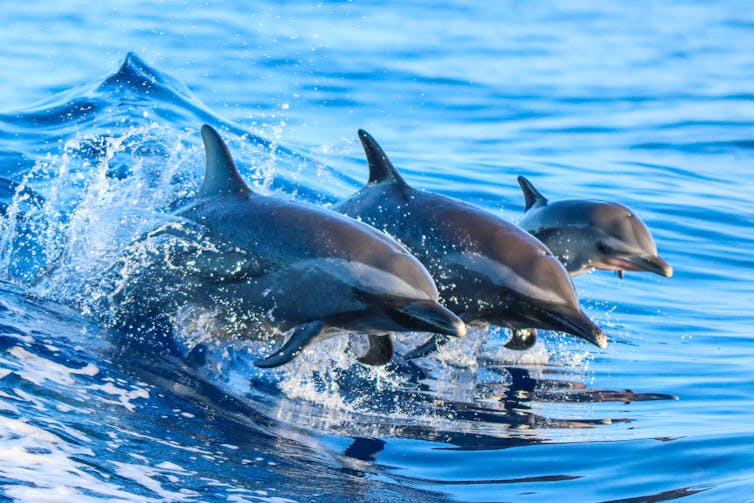
The loquacious “Ripper” was a captive-reared male musk duck at the Tidbinbilla Nature Reserve near Canberra. When he hatched, with the help of a foster bantam hen, he was the only musk duck there.
But even in the wild, musk ducks are odd. Male musk ducks are up to three times larger than females and have a distinctive bulbous lobe of skin hanging from their bills. Their name comes from the musky smell emitted by dominant males.
In the breeding season, males group together (in “leks”) and perform an exciting aquatic courtship displays for females, performing both day and night. Each male performs a structured, audio-visual display with his tail over his back, inflating his throat lobe, and splashing water while whistling loudly.
In the wild, male display whistles seem to form local dialects — a signature of vocal learning. But this doesn’t involve imitations of other species.
Ripper produced many elements of wild display, but would avidly display to people. His bizarre mimicry of anthropogenic sounds formed part of this display.
Mimicking In Captivity
The story of Ripper is part of a long scientific tradition. Captive-reared parrots and some songbirds mimicking human speech feature in ancient European writings, including the works of Aristotle and Pliny the Elder.
More recently, the possible complexities of parrot communication were explored in a pioneering study of “Alex”, the captive African grey parrot, who had a vocabulary of more than 100 words.
By and large, such accounts of human imitations involve a captive individual raised in isolation from others of its own kind, but in close association with a human caretaker. The human caretaker then becomes the social model for the captive bird’s vocal development.
So while these examples reveal an animal’s capacity for vocal production learning, they don’t show that wild animals imitate sounds from their environment. Indeed, very few of the animal species that mimic people in captivity produce anything other than their own, species-specific vocalisations in the wild.
However, this is not true of Australia’s lyrebirds and other avian vocal mimics.
Mimicry In Wild Australia
Two lyrebird species are famous for the diversity and accuracy of their vocal mimicry: the superb lyrebird of the wet eucalypt forests of southeast Australia, and the Albert’s lyrebird of Australia’s subtropical east.
In captivity, male superb lyrebirds have been recorded mimicking anthropogenic sounds ranging from chainsaws, emergency vehicle sirens to this new recording of a crying human baby.
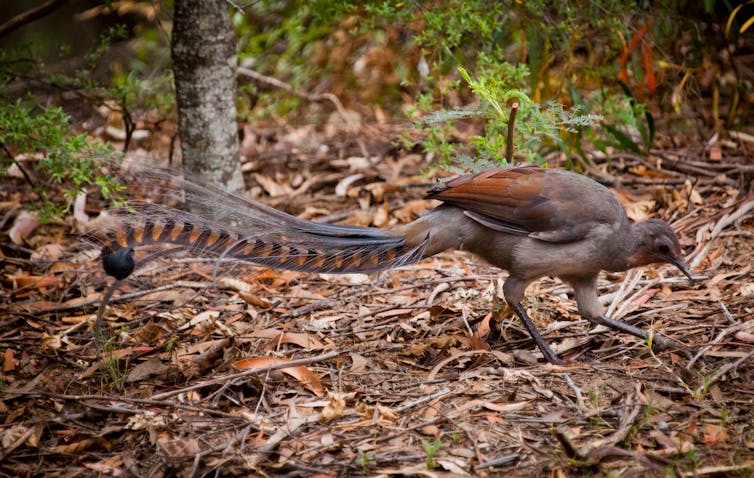
In the wild, both males and females are proficient mimics of the vocalisations and wingbeats of other bird species — and occasionally mammals. A single individual male superb lyrebird can even mimic a flock of alarm-calling birds.
Despite many rumours, it remains a bit of a mystery when and how often wild lyrebirds mimic sounds of human origin.
Lyrebirds aren’t the only ones. Australia is the lucky home to a surprisingly large number of songbird species that regularly mimic in the wild, from tiny thornbills to the large enigmatic bowerbirds that, even in the wild, occasionally produce startlingly accurate renditions of humans.
Read more: The mimics among us — birds pirate songs for personal profit
But not all mimics are what they seem. In a heartbreaking example, the mimetic song of the Regent honeyeater is both a consequence and a cause of the species’ decline. Wild males copy other species because there aren’t enough males left to pass on their song to the next generation.

Threatened Archival Treasures
Ripper the swearing musk duck, Echo the bawling lyrebird, and the forgotten songs of the Regent honeyeater show us how much we still have to discover about Australia’s extraordinary birds. Far from being the biogeographical oddity, Australian birds are still destabilising biological theory.
Ripper was a bird of the 80s, and we only know of his bizarre mimicry because Rippers’ recordist, Dr Peter Fullagar, was on a mission to establish a natural history sound archive for Australia. Like all good 80s singers, Ripper was recorded on cassette tape before Peter digitised it.
It’s only from historical archives that researchers could discover that original song of the Regent honeyeater was unique to the species and more elaborate than the songs of contemporary males. Simply listening to captive-reared birds or the dwindling singers in the wild is no longer enough to reveal the Regent honeyeater’s natural song: the baseline has shifted.
What other treasures lie gathering dust in forgotten sheds or library stacks? We must be quick, before those cassette tapes degrade too far to be heard.
Read more: Only the lonely: an endangered bird is forgetting its song as the species dies out ![]()
Anastasia Dalziell, Postdoctoral research fellow, University of Wollongong and Justin A. Welbergen, President of the Australasian Bat Society | Associate Professor in Animal Ecology, Western Sydney University
This article is republished from The Conversation under a Creative Commons license. Read the original article.
We managed to toilet train cows (and they learned faster than a toddler). It could help combat climate change

Can we toilet train cattle? Would we want to?
The answer to both of these questions is yes — and doing so could help us address issues of water contamination and climate change. Cattle urine is high in nitrogen, and this contributes to a range of environmental problems.
When cows are kept mainly outdoors, as they are in New Zealand and Australia, the nitrogen from their urine breaks down in the soil. This produces two problematic substances: nitrate and nitrous oxide.
Nitrate from urine patches leaches into lakes, rivers and aquifers (underground pools of water contained by rock) where it pollutes the water and contributes to the excessive growth of weeds and algae.
Nitrous oxide is a long-lasting greenhouse gas which is 300 times more potent than carbon dioxide. It accounts for about 12% of New Zealand’s greenhouse gas emissions, and much of this comes from the agricultural sector.
When cows are kept mainly in barns, as is the case in Europe and North America, another polluting gas — ammonia — is produced when the nitrogen from urine mixes with faeces on the barn floor.
However, if some of the urine produced by cattle could be captured and treated, the nitrogen it contains could be diverted, and the environmental impacts reduced. But how might urine capture be achieved?
We worked on this problem with collaborators from Germany’s Federal Research Institute for Animal Health and Research Institute for Farm Animal Biology. Our research is published today in the journal Current Biology. It forms part of our colleague Neele Dirksen’s PhD thesis.
Read more: Feeding cows a few ounces of seaweed daily could sharply reduce their contribution to climate change
Toilet Training (But Without The Nappies)
In our research project, funded by the Volkswagen Foundation, we applied principles from behavioural psychology to train young cattle to urinate in a particular place — that is, to use the “toilet”
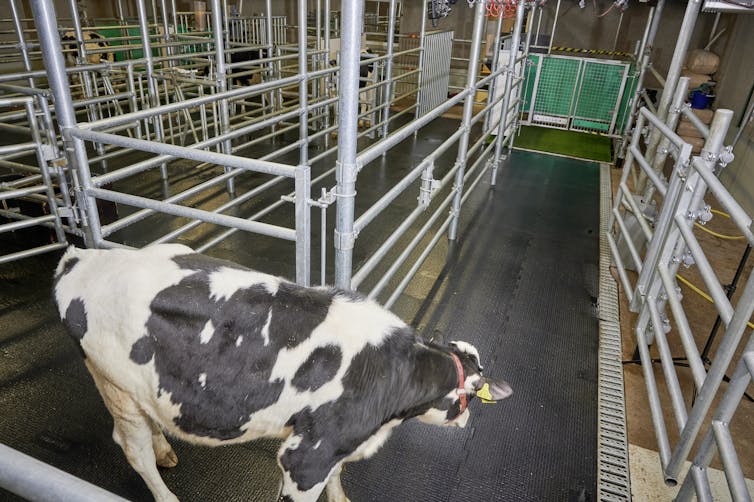
Behavioural psychology tells us a behaviour is likely to be repeated if followed by a reward, or “reinforcer”. That’s how we train a dog to come when called.
So if we want to encourage a particular behaviour, such as urinating in a particular place, we should reinforce that behaviour. For our project we applied this idea in much the same way as for toilet training children, using a procedure called “backward chaining”.
First, the calves were confined to the toilet area, a latrine pen, and reinforced with a preferred treat when they urinated. This established the pen as an ideal place to urinate.
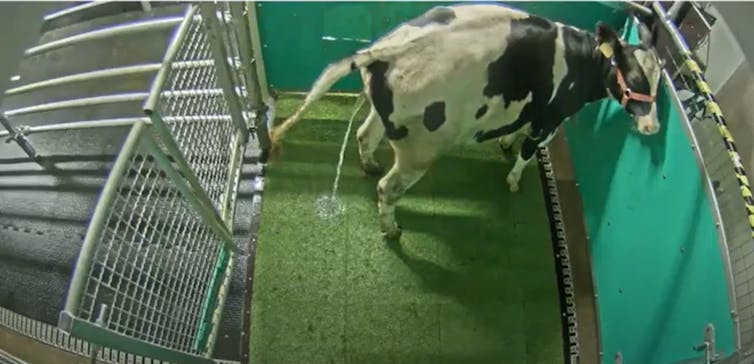
The calves were then placed in an alley outside the pen, and once again reinforced for entering the pen and urinating there. If urination began in the alley, it was discouraged by a mildly unpleasant spray of water.
After optimising the training, seven out of the eight calves we trained learned to urinate in the latrine pen — and they learned about as quickly as human children do.
The calves received only 15 days of training and the majority learned the full set of skills within 20 to 25 urinations, which is quicker than the toilet-training time for three- and four-year-old children.
This showed us two things that weren’t known before.
- cattle can learn to attend to their own urination reflex, because they moved to the pen when ready to use it
- cattle will learn to withhold urination until they’re in the right place, if they’re rewarded for doing so.
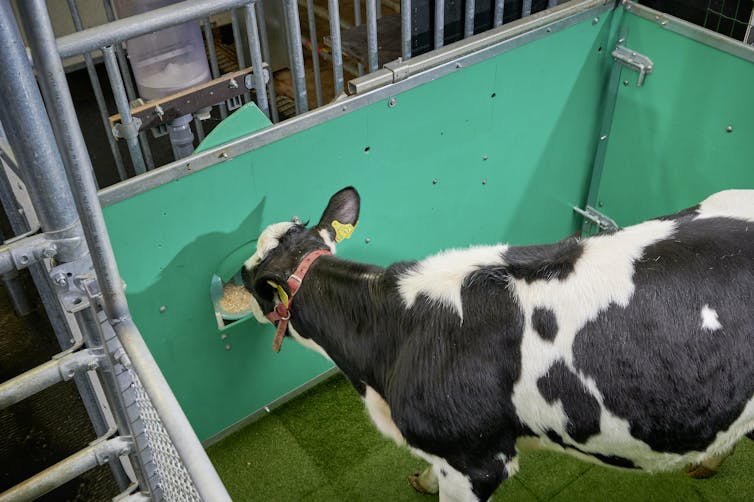
The Next Stages
Our research is a proof of concept. Cattle can be toilet trained, and without much difficulty. But scaling up the method for practical application in agriculture involves two further challenges, which will be the focus in the next stage of our project.
First, we need a way both to detect urination in the latrine pen and deliver reinforcement automatically — without human intervention.
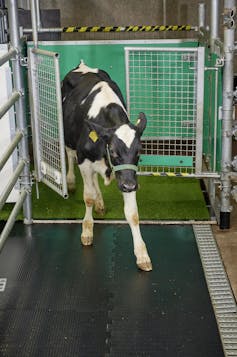
This is probably no more than a technical problem. An electronic sensor for urination wouldn’t be difficult to develop, and small amounts of attractive rewards could be provided in the pen.
Apart from this, we’ll also need to determine the optimal location and number of latrine pens needed. This is a particularly challenging issue in countries such as New Zealand, where cattle spend most of their time in open paddocks rather than barns.
Part of our future research will require understanding how far cattle are willing to walk to use a pen. And more needs to be done to understand how to best use this technique with animals in both indoor and outdoor farming contexts.
What we do know is that nitrogen from cattle urine contributes to both water pollution and climate change, and these effects can be reduced by toilet training cattle.
The more urine we can capture, the less we’ll need to reduce cattle numbers to meet emissions targets — and the less we’ll have to compromise on the availability of milk, butter, cheese and meat from cattle.
Read more: Virtual fences and cattle: how new tech could allow effective, sustainable land sharing ![]()
Douglas Elliffe, Professor of Psychology, University of Auckland, University of Auckland and Lindsay Matthews, Honorary Academic, Psychology Department, University of Auckland
This article is republished from The Conversation under a Creative Commons license. Read the original article.
Saving these family-focused lizards may mean moving them to new homes. But that’s not as simple as it sounds
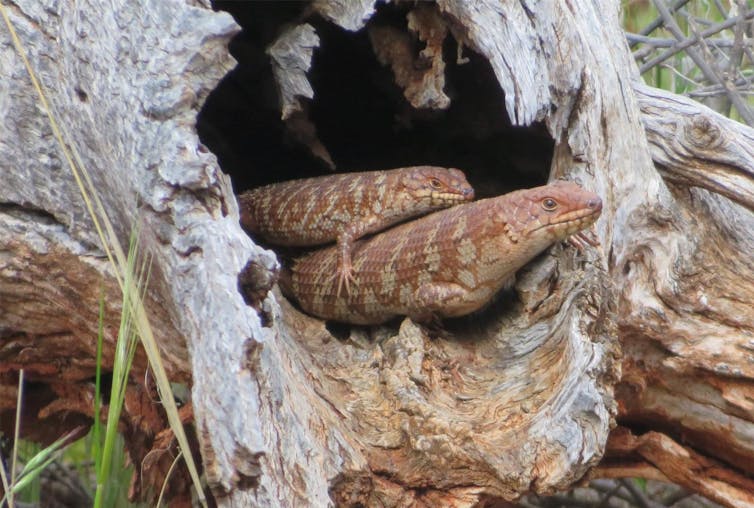
Am I not pretty enough? This article is part of The Conversation’s series introducing you to unloved Australian animals that need our help.
Spiny-tailed skinks (Egernia stokesii badia), known as meelyu in the local Badimia language in Western Australia, are highly social lizards that live together in family groups — an uncommon trait among reptiles.
They’re culturally significant to the Badimia people but habitat degradation and mining has put them under threat of extinction.
These sturdy, mottled lizards — which live in colonies in the logs of fallen trees and branches — are a candidate for what researchers call “mitigation translocation”.
That’s where wildlife are relocated away from high-risk areas (such as those cleared for urban development or mining) to lower risk areas.
It might sound simple. But research shows these mitigation translocation decisions are often made on an ad hoc basis, without a long-term strategic plan in place.
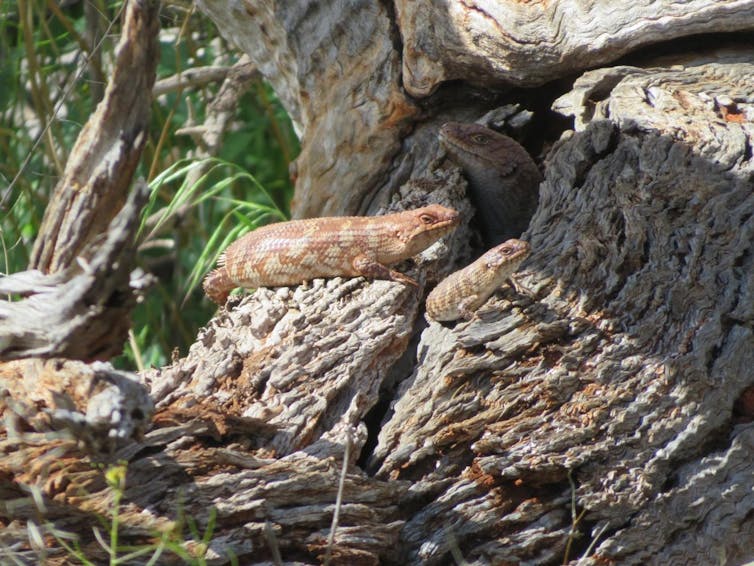
Not Enough Pre-Planning Or Follow-Up
There has been much research into assisted relocation of larger, charismatic mammals and birds. But other animals, such as reptiles with a less positive social image, have been less widely studied.
Our recent research has found there is often little pre-planning or follow-up to monitor success of mitigation translocations, even though reptile mitigation translocations do take place, sometimes on a large scale.
In fact, fewer than 25% of mitigation translocations worldwide actually result in long-term self-sustaining populations.
Mitigation translocation methods are also not being improved. Fewer than half of published mitigation translocation studies have explicitly compared or tested different management techniques.
Mitigation translocation studies also rarely consider long-term implications such as how relocated animals can impact the site to which they are moved — for example, if the ecosystem has limited capacity to support the relocated animals.
But it’s not just about ecosystem benefits. Preservation of species such as meelyu also has cultural benefits — but mitigation translocation can only be part of the solution if it’s done strategically.
Read more: Hundreds of Australian lizard species are barely known to science. Many may face extinction
The Meelyu: A Totem Species
As part of Holly Bradley’s research into understanding how to protect meelyu from further loss in numbers, she had the privilege to meet with Badimia Indigenous elder, Darryl Fogarty, who identified meelyu as his family’s totem.
Totemic species can represent a person’s connection to their nation, clan or family group.
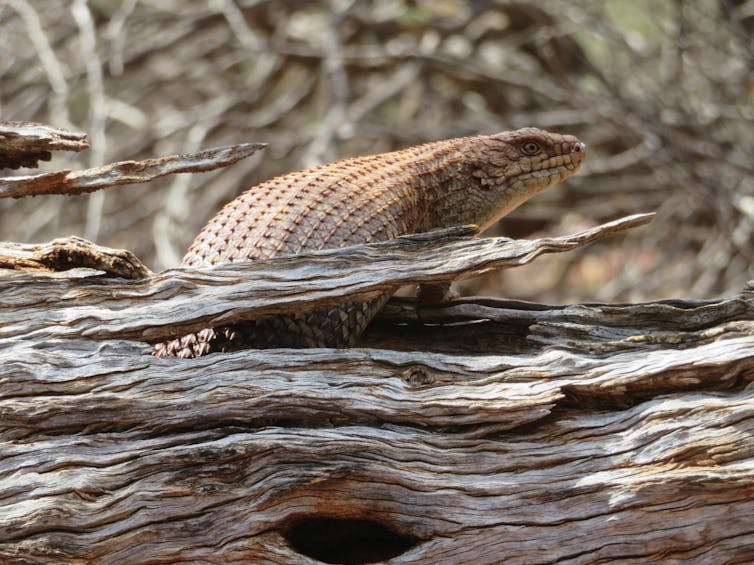
Unfortunately, Darryl Fogarty cannot remember the last time he saw the larger meelyu in the area. The introduction of European land management and feral species into Western Australia has upset the ecosystem balance — and this also has cultural consequences.
Preserving totemic fauna in their historic range can be a critical component of spiritual connection to the land for Indigenous groups in Australia.
In the past, this spiritual accountability for the stewardship of a totem has helped protect species over the long term, with this responsibility passed down between generations.
Before European colonisation, this traditional practice helped to preserve biodiversity and maintain an abundance of food supplies.
A strategic approach to future meelyu relocations from areas of active mining is crucial to prevent further population losses — for both ecological and cultural reasons.
Good Mitigation Translocation Design
If we are to use mitigation translocation to shore up their numbers, we need effective strategies in place to boost the chance it will actually help the meelyu.
Good mitigation translocation design includes factors such as:
selecting a good site and understanding properly whether it can support new wildlife populations
having a good understanding of the animal’s ecological needs and how they fit with the environment to which they’re moving
using the right methods of release for the circumstances. For example, is it better to use a soft release method, where an individual animal is gradually acclimatised to its new environs over time? Or a hard release method, where the animal is simply set free in its new area?
having a good understanding of the cultural factors involved.
A Holistic Approach
A holistic approach to land management and restoration practice considers both cultural and ecological significance.
It supports the protection and return of healthy, functioning ecosystems — as well as community well-being and connection to nature.
Mitigation translocation could have a role to play in protection of culturally significant wildlife like the meelyu, but only when it’s well planned, holistic and part of a long term strategy.
Read more: Photos from the field: Australia is full of lizards so I went bush to find out why ![]()
Holly Bradley, PhD candidate, Curtin University; Bill Bateman, Associate professor, Curtin University, and Darryl Fogarty, Badimia Elder, Indigenous Knowledge
This article is republished from The Conversation under a Creative Commons license. Read the original article.
Research reveals why pet owners keep their cats indoors – and it’s not to protect wildlife

Cat owners are urged to keep their pet indoors for a variety of reasons, including protecting wildlife and preventing the spread of disease. But our research has found an entirely different motivator for containing cats.
Concern for their cat’s safety is the primary reason people keep cats inside. And people who allow cats to roam are also motivated by concern for the animal’s well-being.
Keeping domestic cats properly contained is crucial to protecting wildlife. Cats are natural predators – even if they’re well fed. Research last year found each roaming pet cat kills 186 reptiles, birds and mammals per year.
If we want more domestic cats kept indoors, it’s important to understand what motivates cat owners. Our research suggests messages about protecting wildlife are, on their own, unlikely to change cat owners’ behaviour.

Why Keep Your Cat Indoors?
Cat containment involves confining the animals to their owners’ premises at all times.
In the Australian Capital Territory, cat containment is mandatory in several areas. From July next year, all new cats must be contained across the territory, unless on a leash.
In Victoria, about half of local councils have some form of cat containment legislation. Current revisions to Domestic Animal Management Plans could mean the practice becomes more widespread.
Read more: One cat, one year, 110 native animals: lock up your pet, it's a killing machine
Cats have long been part of human societies and play an important social role in their owners’ lives. But our affection for the animals means efforts to keep cats contained can be met with opposition.
Officials, conservation groups and others put forward a range of reasons for containing cats, including:
preventing cats from spreading diseases and parasites such as toxoplasmosis to both people and wildlife
reducing threats to wildlife, especially at night
reducing unwanted cat pregnancies
avoiding disputes with neighbours, including noise complaints, and cats defecating or spraying in garden beds and children’s sandpits
protecting cats from injury or death - such as being hit by a vehicle, attacked by dogs, snake bite and exposure to diseases and parasites.
So which argument is most persuasive? Our research suggests it’s the latter.

What We Found
We surveyed 1,024 people in Victoria – 220 of whom were cat owners.
We found 53% of cat owners did not allow roaming. These people were more likely to hold concerns about risks to cats’ safety than cat owners who allowed roaming. They were also less likely to believe cats have a right to roam.
Some 17% of cat owners allowed their cats unrestricted access to the outdoors day and night, while 30% contained their cats at night but allowed some unrestricted outdoor access during the day.
Both cat owners and other respondents generally believed cat owners should manage their pet’s roaming behaviour. But for cat owners, concern about harm to wildlife was not a significant predictor of containment behaviour.
Instead, people who keep their cats contained were more likely to be worried that their cat might be lost, stolen, injured or killed.
It’s not that cat owners don’t care about native animals - only about one in ten cat owners said they’d never seriously considered how their cat affects wildlife. But our survey results show this isn’t a big motivation for keeping cats indoors.
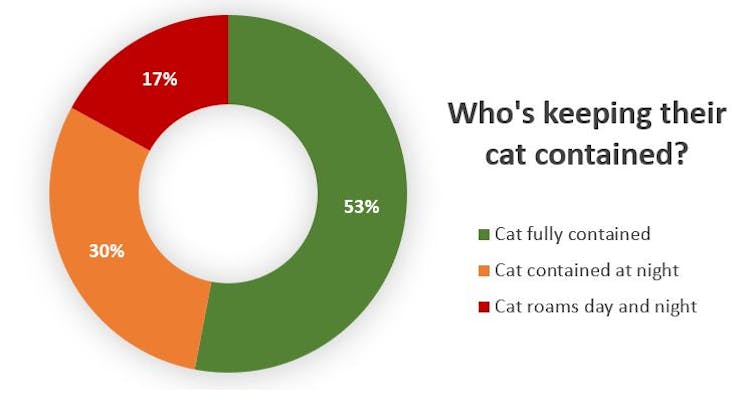
Roaming Is Dangerous
A roaming lifestyle can be risky to cats. A 2019 study of more than 5,300 Australian cat owners found 66% had lost a cat to a roaming incident such as a car accident or dog attack, or the cat simply going missing.
Despite the risks, people who let their cats roam are more likely to think the practice is better for the animal’s well-being – for example, that hunting is normal cat behaviour.
Owners who let their cat roam were more likely than those who contained their cat to believe their cat did not often hunt. While not all cats kill wildlife, those that do typically only bring home a small proportion of their catch. That means owners can be unaware of their cats’ impact.
Cat owners must be made aware of the risks of roaming and equipped with the tools to keep their cats happy and safe at home. Unfortunately, research shows many Australian cat owners are not providing the safe environment and stimulation their cat needs when contained.
Cat containment doesn’t have to mean keeping the animal permanently in the house – nor does it require building them a Taj Mahal on the patio.
Cats can be outside while supervised or walked on leash. You can also cat-proof your backyard fence to keep them in.
Resources such as Safe Cat Safe Wildlife help owners meet their cat’s mental, physical and social needs while keeping them contained.
Changing Containment Behaviour
Our study shows cat containment campaigns can be more effective if messaging appeals to owners’ concern for their cats’ well-being. These messages could be delivered by trusted people such as vets.
Helping owners understand that cats’ needs can be met in containment, and giving them the tools to achieve this, may be the best way to protect wildlife.
Demonising cats is not the answer. The focus must shift to the benefits of containment for cats’ well-being if we hope to achieve a cat-safe and wildlife-safe future.
Read more: I've always wondered: can I flush cat poo down the toilet? ![]()
Lily van Eeden, Postdoctoral research fellow, Monash University; Emily McLeod, PhD Candidate, Queensland University of Technology; Fern Hames, Director, Arthur Rylah Institute for Environmental Research, and Zoe Squires, Policy Officer, Arthur Rylah Institute for Environmental Research
This article is republished from The Conversation under a Creative Commons license. Read the original article.
Climate change is coming for your snacks: why repeated drought threatens dried fruits and veggies

Potatoes can become more brittle, apples may be harder to dehydrate, and sultanas might be off the menu altogether — these are possible outcomes of recurring and intensifying droughts under climate change in Australia.
It might sound counter-intuitive, but drier conditions can affect the quality of fruit and vegetables at a cellular level, making them harder to process into dried foods. This has big implications for Australia’s food security and economy.
Dried foods account for a significant portion of our diet, and Australia exports around 70% of its produce, which is valued at close to A$49 billion per year. Dried produce make up an important part of this — for example, the export value of sultanas, currants and raisins alone in 2018-19 was $25.1 million.
If the taste, quality or availability of dried foods declines, we risk losing these lucrative markets. But my ongoing research on advanced drying methods aims to help overcome this challenge by carefully controlling how cells change their shape and structure.
Droughts Are Set To Get Worse
The most recent report by the Intergovernmental Panel on Climate Change (IPCC) warned Australia will become more arid as the world warms, bringing more droughts, drier soils, mass tree deaths and more.
The recent droughts across much of eastern Australia have already shown how climate change can wreak havoc on plant produce, as well as society and economy. For example, due to climate change impacts, agricultural profits fell by 23% over the period 2001-2020, or around $29,200 per farm, compared to historical averages.
Further, the COVID-19 pandemic has shown that uncertain environmental, social and economic conditions can lead to panic buying, highlighting the importance of food security and the stability of food supply.
It’s important to ensure our dried food supply is up to future stockpiling challenges, as chips and dried fruits are a staple of many diets in Australia. In 2019-2020, dried fruit such as sultanas, dried apple and apricots accounted for 12% of total fruit serves in the country.
How Drought Affects Dried Foods
Australian produce can be dried either in Australia or overseas, depending on the food type, manufacturer and the associated costs.
During the drying process, the cellular structure of fruit and vegetables go through significant changes. Cells and tissues can change their shape while shrinking into more compact forms.
If the drying process is not carefully controlled, it can lead to undesirable properties affecting the food’s taste and appearance, potentially reducing the market value and nutritional quality.
This is how drought makes things difficult. We know drought leads to water shortages in lakes and rivers, but research suggests it also dries out small plant cells and tissues.
If the absence of water in cells is ongoing — due to repeating droughts — the micro-properties of plants and their produce can change in the long term, whether the plants are grown in a large farm spanning hectares or in a small pot in your backyard.

Recurring droughts can make fruit and vegetables “fatigued” even before they’re harvested. This means the structure of the plant weakens with every drought, a bit like how bending a metal wire repeatedly eventually causes it to break.
For example, droughts can make plants, such as apples, more brittle and therefore un-processable. Droughts can also directly lead to smaller plants and respective harvests.
If the drought conditions are extreme, the moisture loss in the plants can be severe and the cells can naturally get damaged even without any further processing. In other words, if the recurring drought conditions are here to stay, dried foods such as potato chips, sultanas and dried apple as we know them could change for good.

Solving This Problem With Supercomputing
So, we know produce affected by drought is not as easy to process, often tastes different and is sometimes not usable at all. But what can we do about it?
Obviously, if climate change and subsequently recurring droughts could be avoided, the adverse effects on the dried food could also be dodged. First and foremost, global emissions must be rapidly and urgently cut.
Read more: Climate change means Australia may have to abandon much of its farming
But what if we can’t avoid it? In this case, we will need a sound Plan B.
One of the promising questions Australian researchers and engineers like me have asked is: can we modify the drying processes to match the changed properties of drought-affected produce? Doing so might enable the dried food processing industry to maintain the quality, taste, appearance and market value of its products.
But it won’t be easy. First, we need to correctly understand the exact nature of shape and size changes in plant cells, as affected by the lack of water. This is challenging, and requires computer simulations and supercomputing technologies.
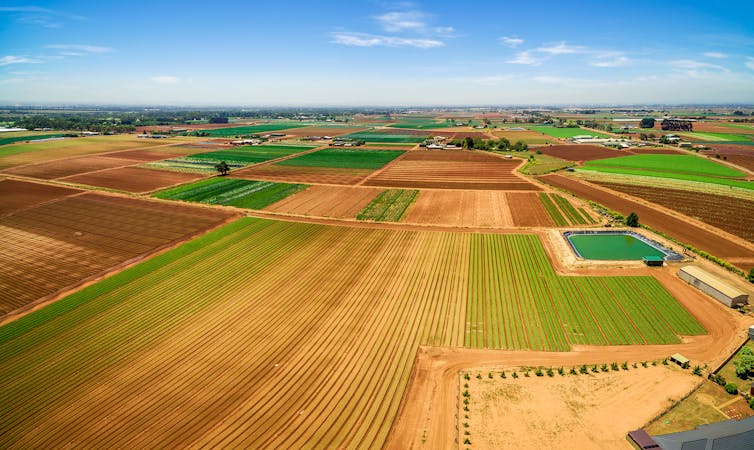
Through these simulations, it’s possible to estimate if the cells are going to be damaged when they go through the drying process. If we find there’ll be serious damage, the simulations can provide information on the ideal drying conditions. This means we can optimise the temperature, pressure, humidity and drying time to minimise the adverse effects.
This approach can lead to significant savings of time, money and energy while leading to increased quality and shelf life of dried food. With more research, extended computer modelling and simulations can lead to advanced drying on an industrial scale, leading to stronger food security and stability.
So, even if we will have to deal with more frequent and more intense droughts in the near future, the taste of your potato chips might be as good as ever, after all.
Charith Rathnayaka, Lecturer in Mechanical Engineering, University of the Sunshine Coast
This article is republished from The Conversation under a Creative Commons license. Read the original article.
Bushcare In Pittwater
Where we work Which day What time
Avalon
Angophora Reserve 3rd Sunday 8:30 - 11:30am
Avalon Dunes 1st Sunday 8:30 - 11:30am
Avalon Golf Course 2nd Wednesday 3 - 5:30pm
Careel Creek 4th Saturday 8:30 - 11:30am
Toongari Reserve 3rd Saturday 9 - 12noon (8 - 11am in summer)
Bangalley Headland 2nd Sunday 9 to 12noon
Bayview
Winnererremy Bay 4th Sunday 9 to 12noon
Bilgola
North Bilgola Beach 3rd Monday 9 - 12noon
Algona Reserve 1st Saturday 9 - 12noon
Plateau Park 1st Friday 8:30 - 11:30am
Church Point
Browns Bay Reserve 1st Tuesday 9 - 12noon
McCarrs Creek Reserve Contact Bushcare Officer To be confirmed
Clareville
Old Wharf Reserve 3rd Saturday 8 - 11am
Elanora
Kundibah Reserve 4th Sunday 8:30 - 11:30am
 Mona Vale
Mona Vale Mona Vale Beach Basin 1st Saturday 8 - 11am
Mona Vale Dunes 2nd Saturday +3rd Thursday 8:30 - 11:30am
Newport
Bungan Beach 4th Sunday 9 - 12noon
Crescent Reserve 3rd Sunday 9 - 12noon
North Newport Beach 4th Saturday 8:30 - 11:30am
Porter Reserve 2nd Saturday 8 - 11am
North Narrabeen
Irrawong Reserve 2nd Saturday 2 - 5pm
Palm Beach
North Palm Beach Dunes 3rd Saturday 9 - 12noon
Scotland Island
Catherine Park 2nd Sunday 10 - 12:30pm
Elizabeth Park 1st Saturday 9 - 12noon
Pathilda Reserve 3rd Saturday 9 - 12noon
Warriewood
Warriewood Wetlands 1st Sunday 8:30 - 11:30am
Whale Beach
Norma Park 1st Friday 9 - 12noon
Western Foreshores
Coopers Point, Elvina Bay 2nd Sunday 10 - 1pm
Rocky Point, Elvina Bay 1st Monday 9 - 12noon
Gardens And Environment Groups And Organisations In Pittwater
Avalon Golf Course Bushcare Needs You
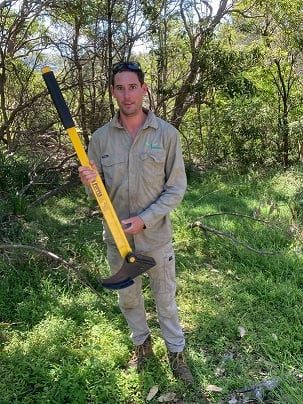
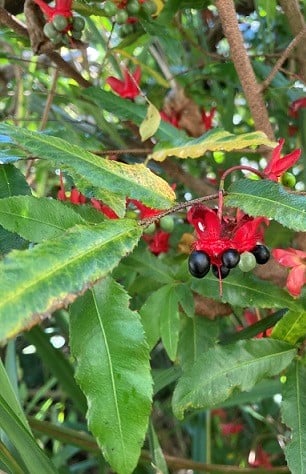
Pittwater Reserves
A History Of The Campaign For Preservation Of The Warriewood Escarpment by David Palmer OAM and Angus Gordon OAM
Angophora Reserve - Angophora Reserve Flowers
Annie Wyatt Reserve - A Pictorial
Avalon's Village Green: Avalon Park Becomes Dunbar Park - Some History + Toongari Reserve and Catalpa Reserve
Bairne Walking Track Ku-Ring-Gai Chase NP by Kevin Murray
Bangalley Headland Bangalley Mid Winter
Banksias of Pittwater
Barrenjoey Headland: Spring flowers Barrenjoey Headland after fire
Bayview Baths
Bayview Wetlands
Beeby Park
Bilgola Beach
Botham's Beach
Bungan Beach Bush Care
Careel Bay Saltmarsh plants
Careel Bay Birds
Careel Bay Clean Up day
Careel Bay Playing Fields History and Current
Careel Creek
Careel Creek - If you rebuild it they will come
Centre trail in Ku-ring-gai Chase National Park
Chiltern Track- Ingleside by Marita Macrae
Clareville Beach
Clareville/Long Beach Reserve + some History
Coastal Stability Series: Cabbage Tree Bay To Barrenjoey To Observation Point by John Illingsworth, Pittwater Pathways, and Dr. Peter Mitchell OAM
Cowan Track by Kevin Murray
Currawong State Park Currawong Beach + Currawong Creek
Deep Creek To Warriewood Walk photos by Joe Mills
Drone Gives A New View On Coastal Stability; Bungan: Bungan Headland To Newport Beach + Bilgola: North Newport Beach To Avalon + Bangalley: Avalon Headland To Palm Beach
Dunbar Park - Some History + Toongari Reserve and Catalpa Reserve
Dundundra Falls Reserve: August 2020 photos by Selena Griffith - Listed in 1935
Elsie Track, Scotland Island
Elvina Track in Late Winter 2019 by Penny Gleen
Elvina Bay Walking Track: Spring 2020 photos by Joe Mills
Elvina Bay-Lovett Bay Loop Spring 2020 by Kevin Murray and Joe Mills
Fern Creek - Ingleside Escarpment To Warriewood Walk + Some History photos by Joe Mills
Ingleside
Ingleside Wildflowers August 2013
Irrawong - Ingleside Escarpment Trail Walk Spring 2020 photos by Joe Mills
Irrawong - Mullet Creek Restoration
Katandra Bushland Sanctuary - Ingleside
McCarrs Creek
McCarr's Creek to Church Point to Bayview Waterfront Path
McKay Reserve
Mona Vale Headland, Basin and Beach Restoration
Mount Murray Anderson Walking Track by Kevin Murray and Joe Mills
Mullet Creek
Narrabeen Creek
Narrabeen Lagoon Catchment: Past Notes Present Photos by Margaret Woods
Narrabeen Lagoon State Park
Narrabeen Lagoon State Park Expansion
Narrabeen Rockshelf Aquatic Reserve
Nerang Track, Terrey Hills by Bea Pierce
Newport Bushlink - the Crown of the Hill Linked Reserves
Newport Community Garden - Woolcott Reserve
Newport to Bilgola Bushlink 'From The Crown To The Sea' Paths: Founded In 1956 - A Tip and Quarry Becomes Green Space For People and Wildlife
Pittwater spring: waterbirds return to Wetlands
Riddle Reserve, Bayview
Salvation Loop Trail, Ku-Ring-Gai Chase National Park- Spring 2020 - by Selena Griffith
Stapleton Reserve
Stapleton Park Reserve In Spring 2020: An Urban Ark Of Plants Found Nowhere Else
The Chiltern Track
The Resolute Beach Loop Track At West Head In Ku-Ring-Gai Chase National Park by Kevin Murray
Towlers Bay Walking Track by Joe Mills
Trafalgar Square, Newport: A 'Commons' Park Dedicated By Private Landholders - The Green Heart Of This Community
Turimetta Beach Reserve by Joe Mills, Bea Pierce and Lesley
Turimetta Beach Reserve: Old & New Images (by Kevin Murray) + Some History
Turimetta Headland
Warriewood Wetlands and Irrawong Reserve
Whale Beach Ocean Reserve: 'The Strand' - Some History On Another Great Protected Pittwater Reserve
Winji Jimmi - Water Maze

New Shorebirds WingThing For Youngsters Available To Download
A Shorebirds WingThing educational brochure for kids (A5) helps children learn about shorebirds, their life and journey. The 2021 revised brochure version was published in February 2021 and is available now. You can download a file copy here.
If you would like a free print copy of this brochure, please send a self-addressed envelope with A$1.10 postage (or larger if you would like it unfolded) affixed to: BirdLife Australia, Shorebird WingThing Request, 2-05Shorebird WingThing/60 Leicester St, Carlton VIC 3053.

 Shorebird Identification Booklet
Shorebird Identification Booklet
The Migratory Shorebird Program has just released the third edition of its hugely popular Shorebird Identification Booklet. The team has thoroughly revised and updated this pocket-sized companion for all shorebird counters and interested birders, with lots of useful information on our most common shorebirds, key identification features, sighting distribution maps and short articles on some of BirdLife’s shorebird activities.
The booklet can be downloaded here in PDF file format: http://www.birdlife.org.au/documents/Shorebird_ID_Booklet_V3.pdf
Paper copies can be ordered as well, see http://www.birdlife.org.au/projects/shorebirds-2020/counter-resources for details.
Download BirdLife Australia's children’s education kit to help them learn more about our wading birdlife
Shorebirds are a group of wading birds that can be found feeding on swamps, tidal mudflats, estuaries, beaches and open country. For many people, shorebirds are just those brown birds feeding a long way out on the mud but they are actually a remarkably diverse collection of birds including stilts, sandpipers, snipe, curlews, godwits, plovers and oystercatchers. Each species is superbly adapted to suit its preferred habitat. The Red-necked Stint is as small as a sparrow, with relatively short legs and bill that it pecks food from the surface of the mud with, whereas the Eastern Curlew is over two feet long with a exceptionally long legs and a massively curved beak that it thrusts deep down into the mud to pull out crabs, worms and other creatures hidden below the surface.
Some shorebirds are fairly drab in plumage, especially when they are visiting Australia in their non-breeding season, but when they migrate to their Arctic nesting grounds, they develop a vibrant flush of bright colours to attract a mate. We have 37 types of shorebirds that annually migrate to Australia on some of the most lengthy and arduous journeys in the animal kingdom, but there are also 18 shorebirds that call Australia home all year round.
What all our shorebirds have in common—be they large or small, seasoned traveller or homebody, brightly coloured or in muted tones—is that each species needs adequate safe areas where they can successfully feed and breed.
The National Shorebird Monitoring Program is managed and supported by BirdLife Australia.
This project is supported by Glenelg Hopkins Catchment Management Authority and Hunter Local Land Services through funding from the Australian Government’s National Landcare Program. Funding from Helen Macpherson Smith Trust and Port Phillip Bay Fund is acknowledged.
The National Shorebird Monitoring Program is made possible with the help of over 1,600 volunteers working in coastal and inland habitats all over Australia.
The National Shorebird Monitoring program (started as the Shorebirds 2020 project initiated to re-invigorate monitoring around Australia) is raising awareness of how incredible shorebirds are, and actively engaging the community to participate in gathering information needed to conserve shorebirds.
In the short term, the destruction of tidal ecosystems will need to be stopped, and our program is designed to strengthen the case for protecting these important habitats.
In the long term, there will be a need to mitigate against the likely effects of climate change on a species that travels across the entire range of latitudes where impacts are likely.
The identification and protection of critical areas for shorebirds will need to continue in order to guard against the potential threats associated with habitats in close proximity to nearly half the human population.
Here in Australia, the place where these birds grow up and spend most of their lives, continued monitoring is necessary to inform the best management practice to maintain shorebird populations.
BirdLife Australia believe that we can help secure a brighter future for these remarkable birds by educating stakeholders, gathering information on how and why shorebird populations are changing, and working to grow the community of people who care about shorebirds.
To find out more visit: http://www.birdlife.org.au/projects/shorebirds-2020/shorebirds-2020-program
Aussie Bread Tags Collection Points

What’s Age Got To Do With It? (2021)
September 14, 2021
A new report released today by the Australian Human Rights Commission has found most Australians (90%) agree ageism exists in Australia, with 83% agreeing ageism is a problem and 65% saying it affects people of all ages.
These findings were included in the Commission’s latest report, led by Age Discrimination Commissioner Dr Kay Patterson AO, What’s age got to do with it? A snapshot of ageism across the Australian lifespan.
The report found ageism remains the most accepted form of prejudice in Australia, with 63% having experienced ageism in the last five years.
“Ageism is arguably the least understood form of discriminatory prejudice, with evidence suggesting it is more pervasive and socially accepted than sexism or racism,” Dr Patterson said.
The research was undertaken by the Commission in 2020 and 2021 to explore what Australians think about age and ageism across the adult lifespan. It found ageism is experienced in different ways:
- Young adults (18-39) are most likely to experience ageism as being condescended to or ignored, particularly at work.
- Middle-aged people (40-61) are most likely to experience ageism as being turned down for a job.
- Older people (62+) are more likely to experience ageism as being ‘helped’ without being asked.
It also shows the generations have much in common – but that there are ongoing tensions, which arise from stereotypes held by one generation about another. When these were questioned, most Australians rejected the stereotype, with:
- 70% of Australians disagreeing that today’s older generation is leaving the world in a worse state than it was before, and
- fewer than 20% agreeing any age group was a burden on their family or a burden on society.
“While we found common stereotypes about different age groups during our research, I was struck by the warmth expressed by participants towards members of age cohorts other than their own – and a real understanding of the life issues faced by those of other age groups,” Dr Patterson said.
The report uncovers what it means to be a certain age is also changing. Increased longevity, changing social mores, cultural factors and economic shifts mean people are realising key milestones at later ages – such as completing an education, buying a home or having children.
Although many questioned whether these life stages should or could be accomplished at a specific age, many stereotypes persist about these sometimes outdated expectations of life stages, including:
- Young adulthood is still seen as the time for gaining an education, starting a career, marrying or partnering, buying a house and starting a family.
- Middle age continues to be regarded as the period of raising a family, progressing a career and strengthening financial security.
- Older age is viewed as being about retiring from paid employment, volunteering, taking up hobbies, travelling, caring for grandchildren and increased dependence.
“In releasing our report, I call on everyone to think about ageism and how it affects you and those close to you,” Dr Patterson said.
“It is incumbent on each of us to discuss these issues and do our bit to bring ageism into mainstream conversations in our workplaces, living rooms, and with our friends.
“Every Australian must do what they can to challenge ageist attitudes in themselves and others, so together we can reduce ageism for Australians of all ages. Age is not the problem. Ageism is.”
Key Findings:
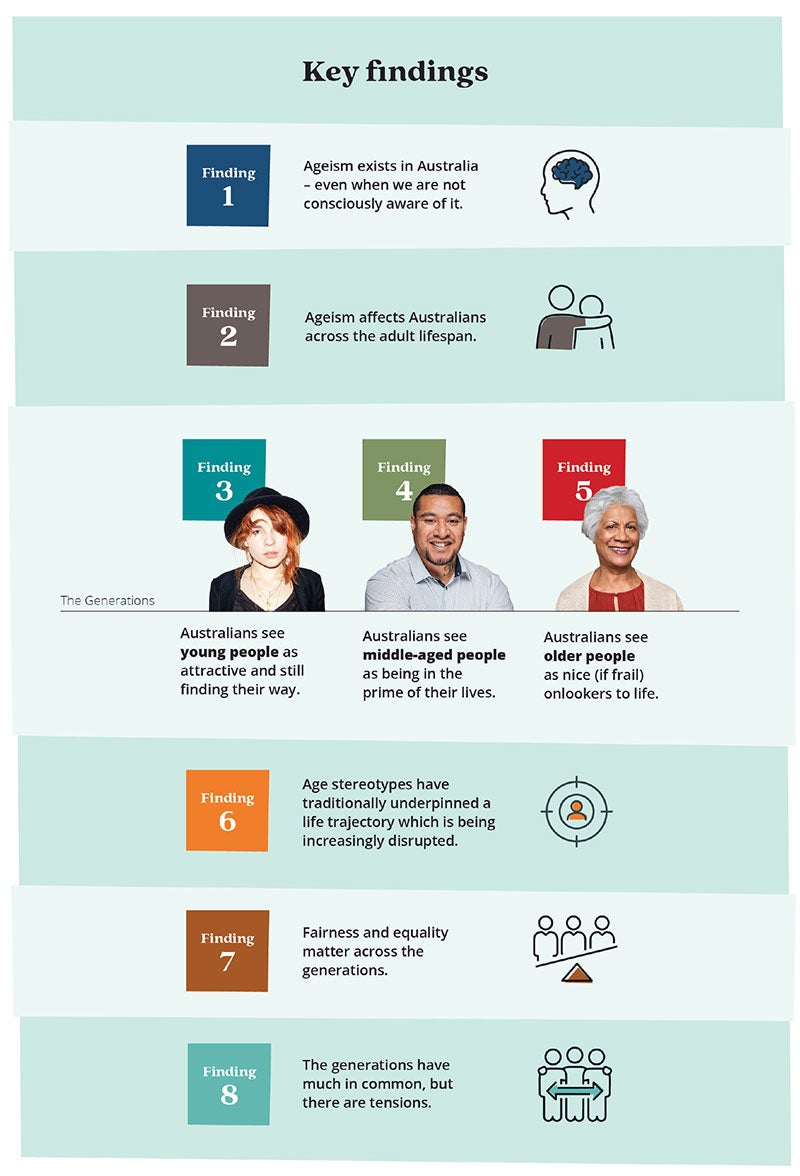
The report is called ‘What’s age got to do with it?’ because it demonstrates that in most life arenas, age is much less relevant than we might often assume.
Age isn’t the problem. Ageism is.
The report is available to download at:
humanrights.gov.au/our-work/age-discrimination/publications/whats-age-got-do-it-2021
Privatising Aged Care Assessments- Why The Fuss?
Currently, if you want to be assessed for taxpayer subsidised aged care you must be assessed by federal government funded Aged Care Assessment Teams (ACAT) or the Regional Assessment Services (RAS). In most cases, these services are delivered by the states and territories.
The Aged Care Royal Commission recommended these services be replaced by a single assessment process.
The federal government agreed and is proposing to do so by putting the services to tender, potentially including aged care providers and other commercial interests.
This has led some state governments, aged care advocates, and medical peak bodies to slam the move as privatising the assessment process.
The latest voice to join in are doctors. The Australian Medical Association (AMA) is urging the government to scrap plans that could potentially privatise the assessment process for aged care services, warning the move would risk the health of older Australians and open the system up to conflicts of interest.
The AMA said the process must remain with the state and territory health services, and be based on Aged Care Assessment Teams, rather than the Regional Assessment Services model that only assesses lower needs.
The Royal Commission did not recommend privatisation but the AMA said the tender process plans leaves assessments open to privatisation and conflicts of interest, with providers likely to seek to take on this role.
“Aged care assessments must remain independent of aged care providers and be delivered by health professionals, especially geriatricians who are trained in dealing with the complex medical needs of the frail and elderly,” AMA President Dr Khorshid said.
The AMA said the Royal Commission’s recommendation was very clear that assessors must be independent from providers because they are effectively deciding on a person’s level of funding for aged care services, such as home care packages.
Government response
The Minister for Senior Australians and Aged Care Services, Senator Richard Colbeck, said the Government has consistently refuted claims that its intention is to privatise the assessment process for aged care.
“The tender arrangements will include measures to ensure that conflicts of interest are managed," said Senator Colbeck.
How aged care assessments are changing
From October 2022, the single assessment workforce will be responsible for residential aged care funding assessments as the transition to the Australian National Aged Care Classification occurs.
The government says this will establish a more integrated aged care system that provides a continuum of services for senior Australians. There are currently three different assessment workforces:
- Regional Assessment Services for the Commonwealth Home Support Programme
- Aged Care Assessment Teams for the Commonwealth Home Support Programme, Short Term Restorative Care, Transition Care, Home Care Packages, Residential Respite and entry to Residential Care, and;
- Clinicians working in residential aged care making assessments for residential care funding.
Health Department information says, “This means under the current arrangements, senior Australians must undergo multiple assessments with different assessment organisations as their needs change, and assessments are not consistent.”
Sources: Australian Medical Association and Australian Government Department of Health
Pension Set To Be Boosted Next Week – But Are You Entitled To More?
September 16, 2021: National Seniors
Higher inflation means the Age Pension will get its biggest boost in three years, but are you entitled to more money through government concessions? Read on to find out.
Next week, the Age Pension will increase – and this should serve as a reminder for you to check what other entitlements you are eligible for using the brand-new National Seniors Concessions Calculator.
According to government figures, older Australians on the Age Pension will receive:
- An extra $22.40 per fortnight for eligible couples (or $582.40 per annum)
- And for singles, $14.80 per fortnight (or $384.80 per annum).
Chief Advocate, Ian Henschke says the pension increase is also an opportunity for seniors to see how else they can save money.
“The hip pocket nerve is hurting a lot of older Australians right now,” Mr Henschke said.
“I urge all pensioners and self-funded retirees to use our Concessions Calculator to see what discounts they can get.”
You can also use the Concessions Calculator to see how your concessions compare to other states when it comes to discounts.
“At a time when we’re all under financial pressure, the Concessions Calculator delivers,” Mr Henschke said.
The calculator is part of a new National Seniors campaign to fight for Fairer Concessions.
Changing Of The Guard
Australia farewelled its iconic Antarctic icebreaker RV Aurora Australis in 2020. Over 31 years the ship completed 150 research and resupply voyages for the Australian Antarctic Program.
So how does its replacement, RSV Nuyina, compare?
Australian Antarctic Division Director, Kim Ellis, said Nuyina extends our operating range and gives us additional days of scientific activity in the Southern Ocean.
“It also allows us to work in collaboration with Australian and international science organisations, to deliver answers to some of the really big questions about climate, biology, and other ocean issues that are so important to us at the moment,” he said.
Shipping Officer, Leanne Millhouse, said the ship's enhanced cargo and fuel-carrying capacity also provided the capability of resupplying and refuelling more than one station at a time.
“That's something that we've not had the ability to do before,” she said.
According to Nuyina's science coordination manager, Jono Reeve, some of the ship’s key differences compared to Aurora Australis are its ‘Silent R’ rating and its advanced ‘dynamic positioning’ system.
The Silent R rating means the ship can operate extremely quietly, when not in icebreaking mode, allowing scientists to use acoustic instruments in the ship's hull and drop keels to map the sea floor, or detect schools of fish or krill.
“If you’re silent you can hear really well and you can hear what’s out there,” Mr Reeve said.
“And if you’re silent you can be stealthy, so that means that the fish don’t go 'what’s that?'. They don’t know you’re there so they keep on doing what they’re doing and you don’t affect them.”
The ship's dynamic positioning system - known as 'DP2' - allows the ship to hold position in bad weather.
“We can have 40-knot winds, currents against us, and big seas, but we can still stay there doing scientific research, rather than waiting for the weather to improve. And operationally it's going to revolutionise our resupply of Antarctica,” Mr Reeve said.
“DP2 means that you can have big things go wrong and it's fine; it can stay there with all its spare thrusters holding it in position, even if something's broken on the ship, so you can assure yourself of the safety, that you're not going to go aground, or something is going to go wrong and dangerous in your operation.”
Nuyina also has the only watertight room of its kind – a 'wet well' for collecting krill and other fragile marine creatures in perfect condition.
Australian Antarctic Division krill biologist, Rob King, said the wet well could process 5000 litres of seawater per minute, allowing scientists to collect healthy, intact specimens that can be transferred to an on board aquarium for immediate research.
“The wet well opens up the opportunity to work on the physiology and the behaviour of specimens that have only ever been available before to teams of divers,” Mr King said.
Perhaps the most apparent difference between Aurora Australis and Nuyina though is the size of the new ship. At more than 65 metres longer than its predecessor, Nuyina will be an unmissable addition to its home port of Hobart.
“I know that when Nuyina comes into Hobart a lot of people are going to be so excited. All of Hobart is going to be just a bit surprised at how big it is,” Mr Reeve said.
Antarctic Icebreaker To Contribute To Global Ocean Map
September 17, 2021
Australia’s new Antarctic icebreaker, RSV Nuyina, will soon be contributing to international efforts to map the global ocean seafloor.
Data collected by Nuyina’s multibeam echosounder will be used to develop navigational charts and detailed maps of the Southern Ocean seafloor, off Australia’s Antarctic stations and between Australia and Antarctica, as part of a newly signed agreement with the AusSeabed initiative.
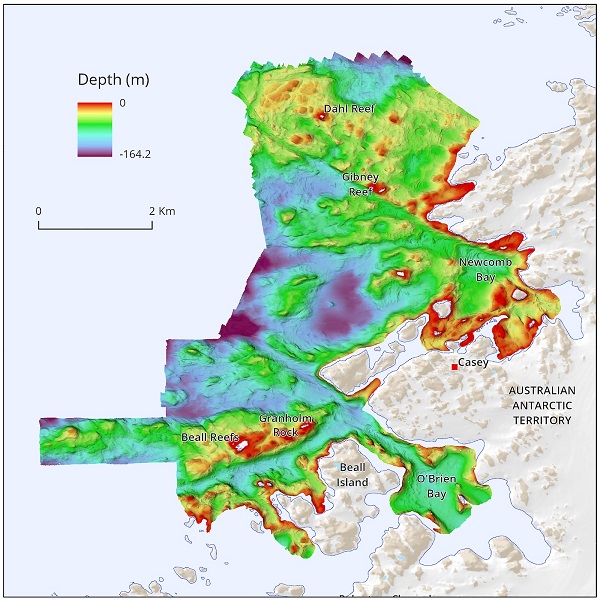
Geoscience Australia and the Royal Australian Navy’s hydrographic survey team have previously mapped seabed features in some locations off Casey and Davis research stations. Nuyina’s acoustic capability will be used to extend this detail [click to see full map]. Photo: AADC
These charts and maps will in turn feed into the Nippon-Foundation-GEBCO Seabed 2030 project, which aims to develop a definitive map of the world’s ocean floor by 2030.
The Antarctic Division’s Data Centre Manager, Johnathan Kool, said the ship’s deep-water echosounder directs pings of sound at the seafloor, which bounce back to reveal what it looks like.
“We can map more than 10 kilometre-wide swaths at a time, collecting as much information as we can while Nuyina is in transit to Antarctica, undertaking science in the Southern Ocean, or operating near our stations,” Dr Kool said.
“The raw data from the ship will be stored in the Antarctic Division’s systems, and our collaborators through AusSeabed, such as the Australian Hydrographic Office and Geoscience Australia, can turn this into navigation charts or bathymetric maps for research purposes, and integrate these into a larger national collection.”
The data will assist the Australian Antarctic Program’s and the broader Antarctic community’s research and operational activities.
“The navigational charts will improve the safety of vessels and anchorage planning around Australia’s Antarctic and sub-Antarctic stations,” Dr Kool said.
“Seabed bathymetry provides information about habitat that can be used in managing Southern Ocean fisheries, or in research planning – such as where to deploy seafloor instruments to study krill.
“And better bathymetry also leads to better ocean models, which leads to better climate projections.
“This is a great example of national and international collaboration that will help address problems that are too big for any one country to solve.”
On the money: Kate Sheppard and the making of a New Zealand feminist icon

In 1992 four New Zealand icons (and the queen) appeared on new banknotes. Part of creating national identity, these notable citizens were chosen to represent the pinnacles of achievement.
Āpirana Ngata, Edmund Hillary, Ernest Rutherford and Kate Sheppard — all in circulation so their acts and values can be admired, celebrated and emulated.
Collectively, the banknote icons signalled a bicultural nation that celebrates Māori knowledge and success, a place where women are equal and where it is possible to lead the world, including in science and exploration.
But while positioned on individual pedestals, these people were also part of citizenship-building that relied on team efforts.
Ngata was one of many talented members of the Young Māori Party. Hillary didn’t climb Everest alone. And Rutherford’s scientific breakthroughs resulted from collaborative work that stood “on the shoulders of giants”.
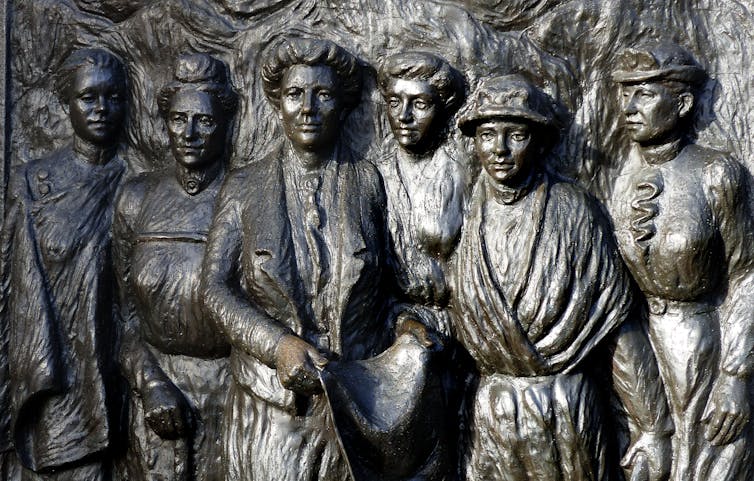
Cast In Bronze
So what of Kate Sheppard’s position? A year after she graced the $10 note, she was put on another pedestal, literally. Unveiled in 1993, the national memorial provides a useful interpretation of the suffrage leader’s place in the collaborative women’s movement of the late 19th century.
The memorial’s Christchurch location, Sheppard’s name in its title and her central position cast in bronze all recognise her leadership. But the monument also recognises how, after the victory, she brought together the networks that had formed during the suffrage campaign.
Sheppard became the first president of the National Council of Women (NCW) in 1896, but flanking her in bronze are others central to the women’s movement.
Meri Te Tai Mangakāhia of Taitokerau requested the vote for women from the Kotahitanga parliament. Amey Daldy was a leader of Auckland’s Women’s Christian Temperance Union (WCTU) and Franchise League. Ada Wells of Christchurch worked for equal educational opportunities for girls and women. Harriet Morison of Dunedin was an advocate for working-class women and active in the Tailoresses’ Union. And Helen Nicol led the important women’s franchise campaign in Dunedin.
The monument also recognises the complex layers and themes of women’s suffrage, including the place of men such as MP Sir John Hall who played a vital part in the suffrage victory. Seven other prominent suffragists are also named. Smaller panels depict generic women going about their daily lives, all part of the wider movement.

An Archetypal Heroine?
So what makes Sheppard so iconic? As well as her role in a world-first episode in New Zealand history, I would argue Sheppard embodies many of the characteristics common to modern heroines globally.
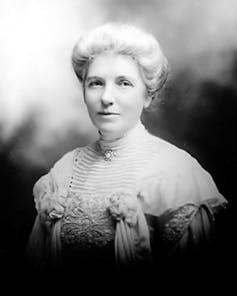
She is emblematic of a mother figure, specifically as a maternal feminist concerned with home, purity and well-being. Metaphorically, her work involves giving birth to the nation.
Accompanied by an image of the symbolic white camellia flower presented to pro-suffrage MPs, Sheppard’s image on the banknote is part of her invention as a feminine, stylishly dressed, commanding figure.
But there are other dynamics at work, too. Sheppard is sometimes framed as a reformer, called to work for a more peaceful and egalitarian society. But the 2015 punk-rock musical That Bloody Woman portrays her as a rebel warrior queen, fighting with bravery and determination.
Read more: Did a tragic family secret influence Kate Sheppard's mission to give New Zealand women the vote?
Intrigue in her private life also adds to Sheppard’s appeal. Was her marriage to Walter Sheppard unhappy? They lived apart from 1905 until he died in 1915. Author Rachel McAlpine wrote a fictional account involving an extramarital affair and a love child.
And what of the rumours surrounding Sheppard’s friendship with William Lovell-Smith, who she married towards the end of her life after the death of his wife Jenny? Her private life hints at mystery and suggests a woman advancing new ways of co-habiting.
There is also tragedy. Sheppard lost her only child, Douglas, in 1910, and outlived her nearest and dearest friends and relations, including her only grandchild.
Sheppard’s shape-shifting presence leaves room for us to create our own versions to augment all the writing she left revealing her beliefs and ideas. The Kate Sheppard Women’s Bookshop aptly memorialises her, and her leadership is honoured through scholarships and awards.
All this has helped keep her memory alive, especially with the feminists who have always claimed her as a heroine.

Who Else But Sheppard?
Sheppard is on the money, then, but who else might represent the heroic archetype? Waikato woman of mana and Kīngitanga leader Te Puea Hērangi is surely one, described by historian J.G.A. Pocock as possibly the most influential woman in New Zealand’s political history.
Te Puea was also a mother figure. A literal healer, she nursed her people back to health — especially after the smallpox epidemic of 1913 and the devastating 1918 influenza epidemic that killed a quarter of the population at Mangatāwhiri, leaving many orphans to be cared for.
Her motto is said to have been “work, eat, pray, work again”. Te Puea was called to help her people and was dedicated to leading their resurgence. In particular, her efforts secured the Kīngitanga movement. Part of her legacy as the most active leader of her generation was the building of Tūrangawaewae marae at Ngāruawāhia.
Like Sheppard, Te Puea’s health and welfare work included campaigns against alcohol and smoking. In the face of Pākehā resistance she built an impressive health facility at Tūrangawaewae. In 1951 she became the first patron of the Māori Women’s Welfare League.
Her activism included seeking compensation for land confiscation. An early peace warrior, she led a non-violent campaign against conscription during the first world war. Like Sheppard, she was part of an international network and well-connected around the Pacific.
Also like Sheppard, Te Puea was strategic and collaborated with many men. She launched Māui Pōmare’s political career and later collaborated with Āpirana Ngata. Well known in the Pākehā world as Princess Te Puea, in 1937 she was made a Commander of the Order of the British Empire.
In many ways, of course, Christchurch and Ngāruawāhia were worlds apart. While both women challenged the state, Sheppard represented a mainstream Pākehā establishment, whereas Te Puea pursued mana motuhake for her people. Yet, placed side by side and viewed through an early 21st-century lens, both are important heroines in history.
Both stand for citizens working together for the common good. Kate Sheppard might be on the money to represent women’s rights as a fundamental part of Aotearoa New Zealand. But, as her memorial suggests, it’s important we don’t see her as the only woman worthy of being on a pedestal.![]()
Katie Pickles, Professor of History, University of Canterbury
This article is republished from The Conversation under a Creative Commons license. Read the original article.
Rice On The Boil In Southern NSW
September 13, 2021
With the rice season set for a superlative start following impressive rains, researchers predict growers will, for the first time this season, sow large areas to the new rice variety, V071.
Bred by the Australian Rice Partnership, a NSW Department of Primary Industries (DPI), SunRice and AgriFutures Australia joint venture, V071 is a semi-dwarf, bold medium-grain rice variety with high yield potential.
DPI research agronomist, Brian Dunn, said V071 offers superior grain yield and cold tolerance compared with Reiziq, a popular semi-dwarf medium grain variety that has elongated grain length.
“Our research shows V071 has strong emergence and establishment vigour with reduced shattering, which will be of interest to growers,” Mr Dunn said.
“Another feature of V071 is that its development continues and does not slow during periods of low temperatures like Reiziq, which is beneficial in cool seasons.”
The latest information to support rice management decisions this season is now available to growers and agronomists with the release of the DPI Rice variety guide 2021-2022 and V071 growing guide.
The DPI rice research team compiled data from several years of agronomy and phenology research experiments to deliver new information on critical sowing times for current varieties, including V071.
Mr Dunn said each field and growing situation has specific characteristics, making some varieties more suitable to their requirements than others.
“It is important to consider all the agronomic characteristics of each variety when selecting those best suited to your field and situation,” he said.
“To minimise the risk of cold conditions reducing grain yield across all crops, we advise growers to grow a mix of varieties, over a range of sowing dates, using a variety of sowing methods.”
DPI, SunRice and Rice Extension continue to work with rice growers and advisers to deliver up-to-date advice.
DPI growing guides for all current NSW rice varieties and supporting rice production Primefacts are available from DPI, Rice Extension and SunRice grower services offices and on the DPI website, https://www.dpi.nsw.gov.au/agriculture/broadacre-crops/summer-crops.
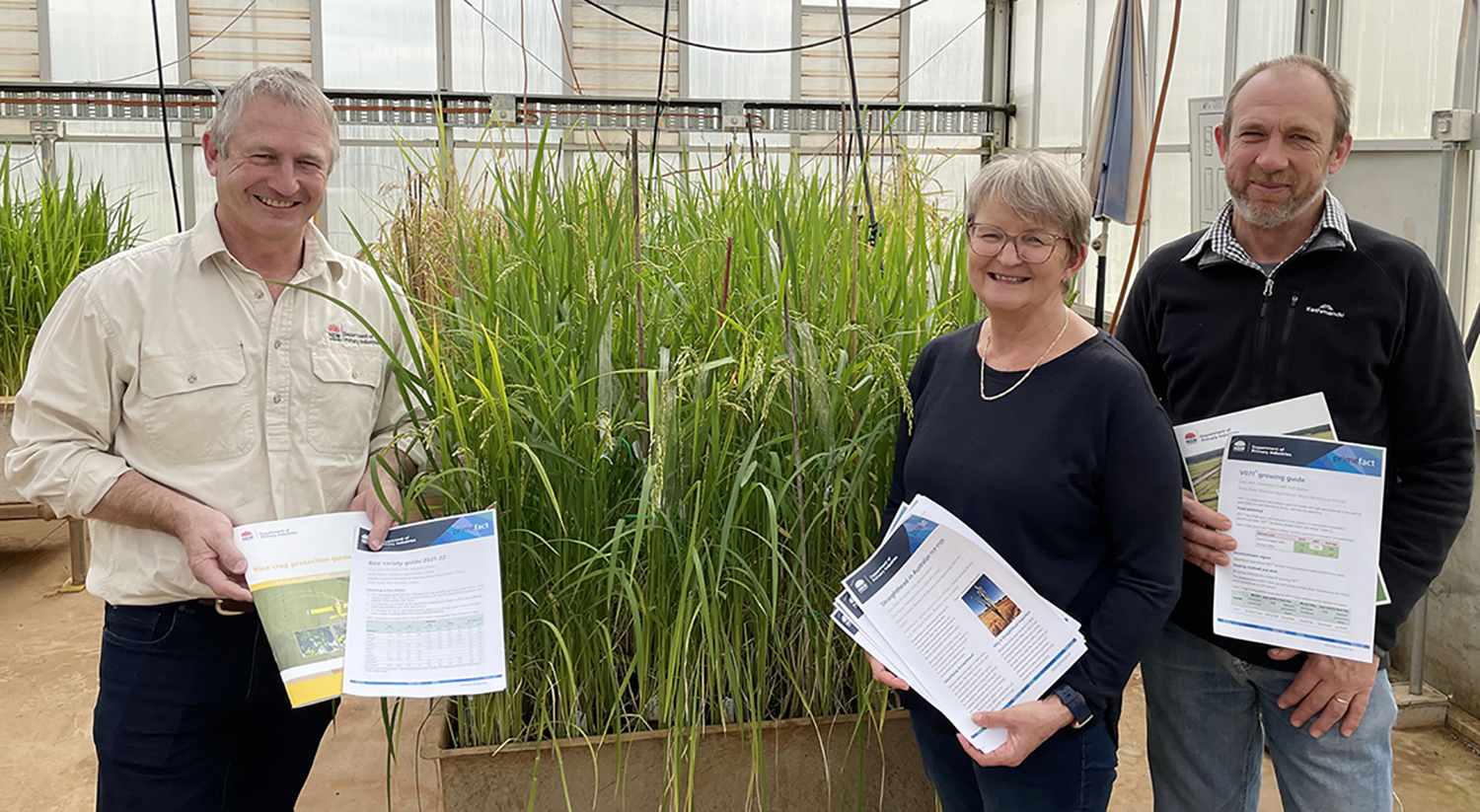
Historic Blue Mountains Tunnel A Step Closer
September 13, 2021
Plans to build Australia’s longest road tunnel between Blackheath and Little Hartley are powering ahead, with a major contract awarded for the environmental assessment.
Deputy Premier and Minister for Regional NSW John Barilaro said AECOM Australia had been selected in a competitive tender process to work on the proposed 11-kilometre tunnel, a central component of the Great Western Highway upgrade between Katoomba and Lithgow.
“This project will transform journeys between the Central West and the East Coast, delivering a safe and more efficient journey for locals, truckies and tourists,” Mr Barilaro said.
“AECOM Australia are industry leaders in their field and bring extensive, demonstrated experience in the environmental assessment of roads and tunnels, having worked on major infrastructure projects, including NorthConnex and the M6 Stage 1.
“They have also demonstrated a comprehensive understanding of the unique and sensitive Blue Mountains environment and will be working to develop rigorous measures to avoid and mitigate impacts from the tunnel work.”
Minister for Regional Transport and Roads Paul Toole said the tunnel would be a game-changer for all motorists driving between Western NSW and Sydney.
“AECOM Australia will now need to ensure that the project includes appropriate measures to protect the Blue Mountains’ natural heritage,” Mr Toole said.
“This critical work will focus on continuing the detailed environmental investigations to confirm the feasibility of a tunnel in this location, and will provide the basis for the Environmental Impact Statement, due for extensive community consultation next year.
“Similar contracts have already been awarded for the east and west sections of the upgrade, so it’s great to see the central section reach that stage too.”
“We’re confident that the assessment will show the feasibility of this ambitious project and that we can build an Australian first right here in the Blue Mountains.”
While designs for Australia’s longest tunnel continue, construction on the east and west sections is set to commence in late 2022.
The $4.5 billion duplication of the Great Western Highway between Katoomba and Lithgow is jointly funded by the Australian and NSW Governments. Construction work is scheduled to start in late 2022, with the tunnel slated to begin construction in 2024.
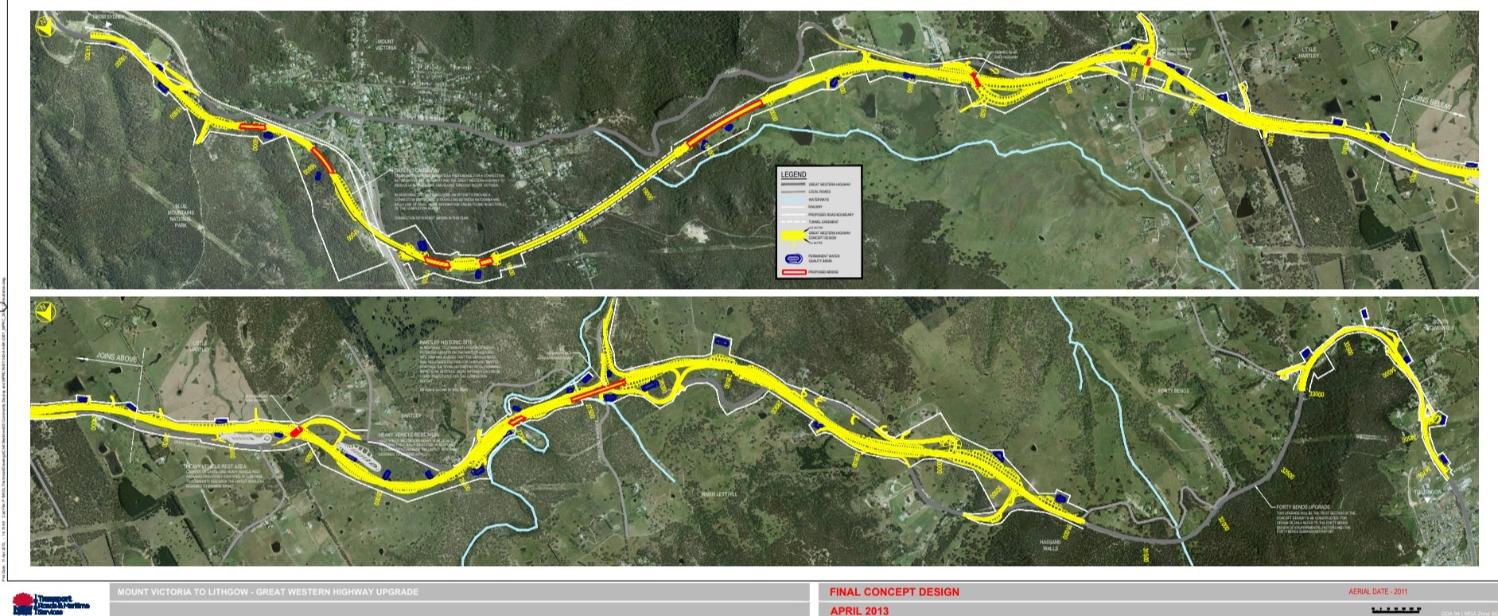
Scientists Claim That Overeating Is Not The Primary Cause Of Obesity
September 13, 2021
Statistics from the Centers for Disease Control and Prevention (CDC) show that obesity affects more than 40% of American adults, placing them at higher risk for heart disease, stroke, type 2 diabetes, and certain types of cancer. The USDA's Dietary Guidelines for Americans 2020 -- 2025 further tells us that losing weight "requires adults to reduce the number of calories they get from foods and beverages and increase the amount expended through physical activity."
This approach to weight management is based on the century-old energy balance model which states that weight gain is caused by consuming more energy than we expend. In today's world, surrounded by highly palatable, heavily marketed, cheap processed foods, it's easy for people to eat more calories than they need, an imbalance that is further exacerbated by today's sedentary lifestyles. By this thinking, overeating, coupled with insufficient physical activity, is driving the obesity epidemic. On the other hand, despite decades of public health messaging exhorting people to eat less and exercise more, rates of obesity and obesity-related diseases have steadily risen.
The authors of "The Carbohydrate-Insulin Model: A Physiological Perspective on the Obesity Pandemic," a perspective published in The American Journal of Clinical Nutrition, point to fundamental flaws in the energy balance model, arguing that an alternate model, the carbohydrate-insulin model, better explains obesity and weight gain. Moreover, the carbohydrate-insulin model points the way to more effective, long-lasting weight management strategies.
According to lead author Dr. David Ludwig, Endocrinologist at Boston Children's Hospital and Professor at Harvard Medical School, the energy balance model doesn't help us understand the biological causes of weight gain: "During a growth spurt, for instance, adolescents may increase food intake by 1,000 calories a day. But does their overeating cause the growth spurt or does the growth spurt cause the adolescent to get hungry and overeat?"
In contrast to the energy balance model, the carbohydrate-insulin model makes a bold claim: overeating isn't the main cause of obesity. Instead, the carbohydrate-insulin model lays much of the blame for the current obesity epidemic on modern dietary patterns characterized by excessive consumption of foods with a high glycemic load: in particular, processed, rapidly digestible carbohydrates. These foods cause hormonal responses that fundamentally change our metabolism, driving fat storage, weight gain, and obesity.
When we eat highly processed carbohydrates, the body increases insulin secretion and suppresses glucagon secretion. This, in turn, signals fat cells to store more calories, leaving fewer calories available to fuel muscles and other metabolically active tissues. The brain perceives that the body isn't getting enough energy, which, in turn, leads to feelings of hunger. In addition, metabolism may slow down in the body's attempt to conserve fuel. Thus, we tend to remain hungry, even as we continue to gain excess fat.
To understand the obesity epidemic, we need to consider not only how much we're eating, but also how the foods we eat affect our hormones and metabolism. With its assertion that all calories are alike to the body, the energy balance model misses this critical piece of the puzzle.
While the carbohydrate-insulin model is not new -- its origins date to the early 1900s -- The American Journal of Clinical Nutrition perspective is the most comprehensive formulation of this model to date, authored by a team of 17 internationally recognized scientists, clinical researchers, and public health experts. Collectively, they have summarized the growing body of evidence in support of the carbohydrate-insulin model. Moreover, the authors have identified a series of testable hypotheses that distinguish the two models to guide future research.
Adoption of the carbohydrate-insulin model over the energy-balance model has radical implications for weight management and obesity treatment. Rather than urge people to eat less, a strategy which usually doesn't work in the long run, the carbohydrate-insulin model suggests another path that focuses more on what we eat. According to Dr. Ludwig, "reducing consumption of the rapidly digestible carbohydrates that flooded the food supply during the low-fat diet era lessens the underlying drive to store body fat. As a result, people may lose weight with less hunger and struggle."
The authors acknowledge that further research is needed to conclusively test both models and, perhaps, to generate new models that better fit the evidence. Toward this end, they call for constructive discourse and "collaborations among scientists with diverse viewpoints to test predictions in rigorous and unbiased research."
David S Ludwig, Louis J Aronne, Arne Astrup, Rafael de Cabo, Lewis C Cantley, Mark I Friedman, Steven B Heymsfield, James D Johnson, Janet C King, Ronald M Krauss, Daniel E Lieberman, Gary Taubes, Jeff S Volek, Eric C Westman, Walter C Willett, William S Yancy, Cara B Ebbeling. The carbohydrate-insulin model: a physiological perspective on the obesity pandemic. The American Journal of Clinical Nutrition, 2021; DOI: 10.1093/ajcn/nqab270
Thousands Of Tiny Anchors Keep Our Cells In Place (And Now We Know How)
September 14, 2021: UNSW
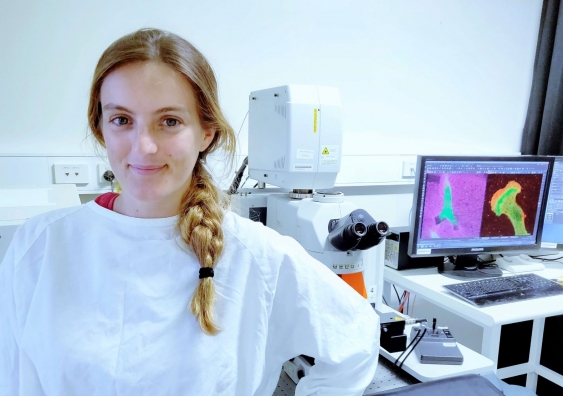
This is the first time scientists have been able to see in detail what the anchor’s chain looks like. Photo: Marco Heydecker.
Most of the cells in our bodies – be they bone, muscle or pancreas cells – are locked into the right place with the help of tiny anchors (called ‘focal adhesions’). These strong anchors use protein chains to link the cell to collagen, the protein that gives structure to our body.
The anchors help the cells stay put and, for the most part, resist disruptions to their environment – but if a cell morphs into a cancer cell, the chain can break, letting the cancer spread to other parts of the body.
Now, for the first time, a team of UNSW Sydney scientists have found the specific protein (or link) in the chain responsible for upholding the connection.
The findings, published today in Nature Materials, build on our understanding of cell mechanics – and could help give new directions for cancer research.
“We’ve identified the protein that’s essential for these attachments to function,” says Ms Maria Lastra Cagigas, lead author of the study and Scientia PhD candidate at UNSW Medicine.
“If these attachments fail, the cell could be more prone to moving and invading tissues, like cancer.”
Scientists already knew that cancer weakens cells’ anchors in some way, but they didn’t know exactly how this happens.
One of the reasons it’s been so hard to study this is the miniscule size of the anchor’s chain: it’s only a few nanometres thick – about 1/10,000th the size of a human hair.
The team used specialised 3D cryo-electron microscopy – a powerful imaging technique that uses an electron microscope to create high-resolution images of cells – to identify tropomyosin as the key protein in the chain holding the anchor in place. Cryo-electron microscopy is currently the most powerful technique to look at proteins inside cells, and its development won the Nobel Prize in Chemistry in 2017.
“This is the first time we can actually see in detail what the anchor’s chain looks like,” says Professor Peter Gunning, co-senior author of the study. The team made the findings at UNSW’s Mark Wainwright Electron Microscope Unit, and are the first in the world to use this technique to look at these tropomyosin chains.
“It’s completely new technology.”
The researchers identified tropomyosin’s role in the anchor’s chain by comparing normal cells with cells from bone cancer patients, along with cancer cells created in the laboratory.
They then tried putting the tropomyosin back into the cancer cells – surprisingly, the anchors managed to attach again.
“Looking into the future, we want to learn if we can leverage this knowledge to reduce the invasion of cancer cells,” says Ms Lastra Cagigas.
“In the short term, we could use this information to find out if a cancer has a predisposition to metastasize, which means to move throughout the body.
“In the long term, we could look into it as a potential target in cancer treatment.”
Prof. Gunning and co-senior author Professor Edna Hardeman, who have been researching this field of science for 40 years, say it’s a milestone in understanding cell mechanics.
“It's been a real pleasure to watch this work develop,” says Prof. Gunning, who was recently presented with the 2020 President’s Medal from the Australian and New Zealand Society for Cell and Developmental Biology (ANZSCDB) for his contribution to research into cell mechanics.
“It reinforces what has essentially been a lifetime's work for us: understanding the principles of the architecture of cells.”
A potential drug target
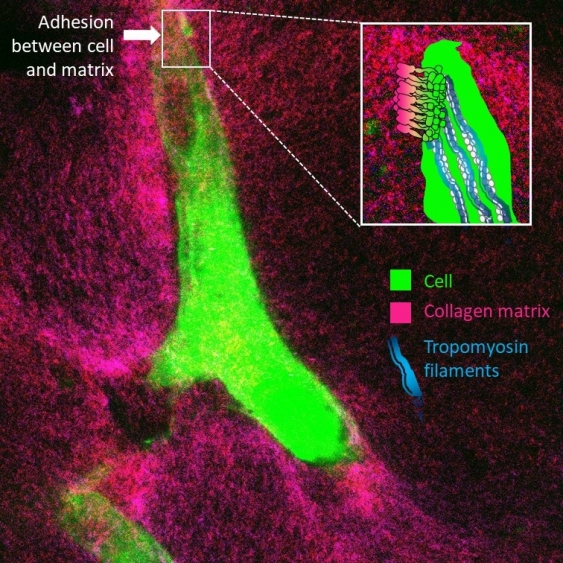
Around 30 per cent of the body is made up of collagen, which forms what’s called ‘the matrix’.
“The matrix is like a scaffold present in our bones, ligaments, muscles, and skin. It’s almost everywhere in the body,” says Ms Lastra Cagigas. “Other than the cells that move through our body, like those in blood, the collagen matrix forms the home for most cells – including cancer cells.”
Pancreatic cancer is one of a few cancers that can modify this matrix for its own benefit by creating a ‘barrier’ around the tumour. This barrier works as a defence mechanism, making it harder for cancer treatments like chemotherapy and immunotherapy to kill the cancer cells.
The tumour forces pancreatic cancer-associated fibroblasts (or PCAFs) – cells around the tumour that are anchored by chains – to build this defence barrier. But now that scientists have identified the proteins in the cell’s anchor and chain, they can explore these proteins as future targets for therapies that could loosen that barrier.
“We’ve identified that the type of protein involved in the chain, tropomyosin, is druggable,” says Prof. Hardeman.
“This means it’s possible to develop small molecule inhibitors, or drugs, that can actually attack these proteins.”
Prof. Hardeman says it’s likely that these potential future drugs would be delivered alongside cancer treatments, so the drugs can temporarily destabilise the barrier while the cancer treatments do their work.
A fibroblast cell (shown here in green) in the process of attaching to the collagen matrix (pink). The tropomyosin filaments (blue) are essential to forging – and keeping – this connection. Image: Maria Lastra Cagigas & Michael Carnell / Katharina Gaus Light Microscopy Facility.
Looking ahead
While the findings are encouraging, Prof. Gunning says it doesn’t mean suitable drugs will be available for use in the next few years.
“We have an understanding of the biology, but to go from that to treating a patient is difficult to predict,” he says.
“We can see what the path looks like, but we are less sure of the timeline.”
It’s more likely that in the near future – potentially the next two or three years – the protein in the chain, tropomyosin, may help scientists predict which cancers are likely to spread more quickly.
“As we build on the underlying mechanisms of cancer and expand our markers of cancer cell biology, our discovery adds a missing link to the development of a personalised diagnosis for cancer,” says Prof. Gunning.
Disclaimer: Prof. Peter Gunning and Prof. Edna Hardeman have established a company that is developing drugs that target the tropomyosins for a number of health conditions. While drug development was not explored in the research paper, future possibilities of this research, including potential drug developments, are mentioned in this press release.
The government is determined to keep National Cabinet’s work a secret. This should worry us all
Cheryl Saunders, The University of MelbourneEarlier this month, the Morrison government introduced a bill to parliament that would amend the Freedom of Information Act to allow meetings of the National Cabinet to receive the same exemptions from releasing information to the public as the federal cabinet.
The protection would be considerable. The bill would expand the definition of “cabinet” in the act to include the National Cabinet or one of its committees, and would redefine “minister” to include state ministers.
The exemption would also cover not only National Cabinet meetings themselves, but a host of other bodies associated with it under the convoluted architecture for intergovernmental relations in Australia. This chart shows just how confusing it gets.
The bill has been referred to a Senate committee, which is due to report on October 14. There is a lot at stake. The bill certainly should not pass in its present form.
What’s This All About?
The bill is a response to the decision of the Administrative Appeals Tribunal (AAT) in a case brought by Senator Rex Patrick to force the government to release certain National Cabinet records.
In that decision, the AAT rejected the government’s claim that National Cabinet documents were exempt from release under the Freedom of Information (FOI) Act. The tribunal did so on the basis that a forum in which heads of Australian governments meet is a completely different kind of body to a cabinet.
Read more: Nowhere to hide: the significance of national cabinet not being a cabinet
A cabinet comprises ministers in the same government, who are elected to the same parliament, to which they are accountable and collectively responsible.
By contrast, a meeting of National Cabinet comprises the leaders of nine separate jurisdictions, with cabinets, parliaments and lines of accountability of their own.
The government decided not to appeal the AAT decision, but has moved to amend the FOI Act instead.
There have been meetings of heads of Australian governments since before federation. For around 100 years, these were known as the premiers’ conference. In 1992, the name was changed to the Council of Australian Governments, or COAG.
COAG today has ceased to exist — National Cabinet has replaced it. It is, however, essentially the same body with a new name and some altered procedures to respond to the pandemic.
What The Current Bill Would Do
None of these bodies was set up by legislation. Over the almost 30 years of its existence, however, COAG came to be mentioned in passing in a lot of legislation dealing with federal, state and territory government relations.
This explains the title of the current bill: the COAG Legislation Amendment Bill.
Interestingly, the first two sections of the bill (“schedule one” and “schedule two”) amend a host of acts referring to the old name, COAG. None of the amendments, however, uses “National Cabinet” as a substitute. Instead, for example, the COAG Reform Fund would become the Federation Reform Fund and references to COAG alone would become First Ministers’ Council.
Against this background, the amendments in schedule three to the FOI Act — and many other acts — seem even more peculiar.
Here, National Cabinet is referred to by name, and the amendments define the federal cabinet to include “the committee known as the National Cabinet”. This begs the question: known by whom? If the answer lies in the terminology used by the prime minister, what other bodies might this bill ultimately cover?
How Confidential Should National Cabinet Be?
The bill raises an important question of the extent to which decisions of National Cabinet should be available to parliaments, the media and the public.
The need for transparency and accessibility is pressing. Over the course of the pandemic, the National Cabinet has made a host of significant decisions about how public power will be exercised, when and by whom. Its decisions have dramatically affected the lives of all Australians for almost two years.
In many ways, the National Cabinet’s effectiveness relies on public cooperation and trust. The only publicly available information about its decisions, however, comes through bland press releases, discursive remarks at Prime Minister Scott Morrison’s press conferences, and the occasional leak to selected journalists.
The lack of public knowledge about what goes on in National Cabinet cuts across all the principles and practices of representative democracy — at the Commonwealth level and in each of the states and territories.
There may well be a case for keeping some aspects of what goes on in National Cabinet confidential. The decisions are difficult and negotiations may be tense. Outcomes are sometimes unpredictable and public opinion can be febrile. It’s also in the public interest to encourage frank exchanges between political leaders and innovative thinking about solutions.
These considerations suggest there may be a case for the confidentiality of some aspects of the National Cabinet and preliminary working documents.
There is no comparable rationale, however, for withholding information about the decisions that have been made, any finalised documents on which they are based and understandings about the action expected to be taken.
These matters would be exempt under the bill. They should be in the public domain.
Compounding The Confusion
By enshrining the words “National Cabinet” in legislation, the bill also entrenches the foolish and inappropriate name that was adopted without apparent deliberation as the pandemic began to unfold.
Perpetuating this way of describing the a forum of heads of government puts at least two of our most basic principles of government at risk.
Read more: Will national cabinet change federal-state dynamics?
One is federalism. It is bizarre to describe the meeting of heads of Australian government as a subcommittee of the cabinet of one of its members (the federal government).
This could be destructive to healthy relations between federal, state and territory governments in the future.
The second risk is to the idea of a “cabinet” itself — and, by extension, responsible government.
The concept of a cabinet is hard enough for people to understand. It depends almost entirely on constitutional convention, reinforced by the logic of the relationship between government and parliament.
No doubt the frequency with which the term is used gives observers some general understanding of what a cabinet does. But if the understanding is muddled by applying the term “cabinet” to a body of an entirely different kind, the potential for confusion is magnified.
This comes with considerable loss to our democracy, and no gain.![]()
Cheryl Saunders, Laureate Professor Emeritus, Melbourne Law School, The University of Melbourne
This article is republished from The Conversation under a Creative Commons license. Read the original article.
ASIC, now less a corporate watchdog, more a lapdog

The implosion of Australia’s corporate watchdog, the Australian Securities and Investments Commission, under the federal government’s new directions, has gone from tragedy to farce.
ASIC was described as “weak, hesitant and timid” in a 2014 Senate review of its performance. To be fair, that was before ASIC’s current leadership. Now any assessment could add “dazed and confused”.
Last week we got a dose of that in the doublespeak of ASIC’s new chair Joseph Longo and deputy chair Sarah Court in their “first significant media interview” — with the Australian Financial Review.
The pair were asked about ASIC’s commitment to the “why not litigate?” approach recommended in 2019 by the Hayne royal commission into misconduct in the financial services industry.
Following the litany of revelations where the corporate regulator had failed to take action against illegal behaviour, royal commissioner Kenneth Hayne made it clear that when ASIC saw a law broken, its obligation, in deciding on a response, was to first ask itself “why not litigate”?
“I love litigation,” Longo told the AFR. “It’s what I used to do and Sarah is an expert at it.”
But in the same interview Court — ASIC’s head of enforcement — said the why-not-litigate strategy “has had its day”.
Regulatory Doublespeak
Confusion is to be expected when a regulator is told to both enforce and refrain from enforcing the law — which is effectively what the federal government did last month in the “statement of expectations” it handed ASIC.
The previous statement, issued in 2018, began with acknowledging “the independence of ASIC and its responsibility for market conduct regulation”.
The new statement begins by saying ASIC is expected to “identify and pursue opportunities to contribute to the Government’s economic goals”.
Read more: Frydenberg's directions to ASIC throw the banking royal commission under a bus
ASIC accepted the banking royal commission’s why-not-litigate recommendation in 2019. But the federal government’s view of this was underlined last Friday when Longo fronted the House of Representatives’ standing committee on economics.
The committee’s chair, Tim Wilson, slammed the “why not litigate” approach as binary, wrong-headed and farcical. He also disputed that ASIC was too close to regulated companies, despite the overwhelming evidence to the contrary.
Return To Enforceable Undertakings
The answers Longo and Court gave the AFR also suggest ASIC is backing away from the Hayne royal commission’s recommendation on “enforceable undertakings” — by which transgressors negotiate a settlement without an admission of wrongdoing.
A regulator might think using enforceable undertakings was better than taking a company to court, Commissioner Hayne said in his final report.
But that view cannot be formed without having first given proper consideration to questions of deterrence, both general and specific. A regulatory response to a breach of law that does not deter, generally and specifically, will rarely be a more effective regulatory outcome.“
Court, however, told the AFR:
My own view is that an enforceable undertaking can be completely appropriate in the right circumstance. Infringement notices can be completely appropriate.
Royal Commission’s Fading Influence
The impression gained is of an attempt to pay some lip service to the royal commission but also demonstrate fealty to the federal government.
The federal government repeatedly resisted the royal commission, then backed away from its commitment to act on all the recommendations. What has changed since the royal commission? Not much.
Read more: Ideology triumphs over evidence: Morrison government drops the ball on banking reform
Last week the Federal Court fined Westpac A$10.5 million for deceptive behaviour towards members of the Westpac-owned BT Superannuation Fund - a ruling stemming from litigation initiated by ASIC in 2016. This is the same BT ordered two weeks ago by the Australia Prudential Regulatory Authority to advise about 500,000 members of its Retirement Wrap fund that they should leave the fund, so bad have their returns been.
In his judgement, Justice Michael O'Bryan criticised Westpac for failing to fix its compliance failures, tardiness in compensating customers and lack of apology: "Westpac has not expressed regret for the conduct, does not appear to have taken steps to remedy the compliance deficiencies and has been tardy in progressing a remediation plan.”
At least, though, ASIC litigated against Westpac — successfully pursuing an appeal when it lost its first case. What chance would there be of achieving a fair outcome for consumers from a “no-regrets Westpac” had it not gone to court? Not much.
Australia’s battered and bruised financial consumers have every right to say to the regulator, and the government: enforce the law, or get out of the way.![]()
Andrew Schmulow, Senior Lecturer, Faculty of Law, University of Wollongong
This article is republished from The Conversation under a Creative Commons license. Read the original article.
COVID-19 Killing Coating A Spray Away
September 15, 2021
An antiviral surface coating technology sprayed on face masks could provide an extra layer of protection against COVID-19 and the flu.
The coating developed at The University of Queensland has already proven effective in killing the virus that causes COVID-19, and shows promise as a barrier against transmission on surfaces and face masks.
UQ’s Australian Institute for Bioengineering and Nanotechnology researcher Professor Michael Monteiro said the water-based coating deployed worm-like structures that attack the virus.
“When surgical masks were sprayed with these ‘nanoworms’, it resulted in complete inactivation of the Alpha variant of Sars-CoV-2 and influenza A,” Professor Monteiro said.
The coating was developed with Boeing as a joint research project, and was tested at the Peter Doherty Institute for Infection and Immunity at The University of Melbourne.
“These polymer ‘nanoworms’ rupture the membrane of virus droplets transmitted through coughing, sneezing or saliva and damage their RNA,” Professor Monteiro said.
“The chemistry involved is versatile, so the coating can be readily redesigned to target emerging viruses and aid in controlling future pandemics.”
Professor Monteiro said face masks would continue to be an important part of helping prevent or reduce community transmission of COVID-19.
“Antiviral coatings applied on mask surfaces could reduce infection and provide long-lasting control measures to eliminate both surface and aerosolised transmission,” he said.
“We know that COVID-19 remains infectious for many hours or days on some surfaces, and provides a direct route to infection.
“Therefore, there is greater emphasis on eliminating both surface and airborne transmission to complement vaccination of the population to stop the current pandemic.”
The coating is environmentally friendly, water-based and its synthesis aligns with manufacturing techniques used in the paint and coatings industry.
The research, Water-Borne Nanocoating for Rapid Inactivation of SARS-CoV-2 and Other Viruses, is published in ACS Nano (doi.org/10.1021/acsnano.1c05075)

Professor Michael Monteiro
World-First 3D Imaging For Melanoma Detection
September 13, 2021
Queenslanders could have skin cancer diagnosed earlier using world-first 3D scanning technology with the launch of the Australian Cancer Research Foundation Australian Centre of Excellence in Melanoma Imaging and Diagnosis.
University of Queensland Dermatologist Professor H. Peter Soyer said the technology enabled researchers to track moles and skin spots over time using full body mapping, making it a game-changer for melanoma detection.
“This technology is revolutionising early melanoma detection using 3D state-of-the-art body imaging systems that take an image in milliseconds,” Professor Soyer said.
“The telemedicine network allows dermatologists and medical professionals to detect skin cancers remotely, even from the other side of the country.
“For the first time, medical researchers can access a national database of up to 100,000 patient images taken by 3D full body imaging systems located in Queensland, NSW and Victoria, as part of the world’s largest melanoma imaging trial, which aims to develop more efficient and effective screening for the early detection of skin cancer.
“Using algorithms created by artificial intelligence, the 3D imaging systems are able to analyse the images and produce a full body skin spot map, which transforms the way we will monitor patients in the future.”
Australia has the highest rates of melanoma in the world with an average 28,000 Australians diagnosed with the disease every year.
ACRF chief executive officer Kerry Strydom said the Australian Cancer Research Foundation backed the best in research and cutting-edge technology to drive innovation and help create the new Centre.
“Melanoma is a deadly problem that needs disruptive solutions, and ACRF is proud to be to be involved in delivering revolutionary research through this pioneering program,” Mr Strydom said.
The project brings together three leading Australian universities in skin research, UQ, The University of Sydney and Melbourne’s Monash University, to form the interconnected Centre of Excellence in Diagnostic Imaging of Early Melanoma.
Queenslanders can sign up here to be part of the world’s largest melanoma imaging trial using the 3D full body imaging system located at Brisbane’s Princess Alexandra Hospital.
The 3D technology is expected to be rolled out to five other regions across Queensland.
Koala Killer Being Passed To Joeys From Mum
September 2021
A deadly koala virus that can cause immune depletion and cancer, known as koala retrovirus, is being transferred to joeys from their mothers, according to University of Queensland scientists.
Associate Professor Keith Chappell, from UQ's School of Chemistry and Molecular Biosciences, said the virus predisposes koala to chlamydia and other disease, and is having a large impact on our wild koala populations across Queensland and New South Wales.
"Koala retrovirus -- also known as KoRV -- and associated diseases are another threat facing koalas, along with climate change and habitat loss.
"The virus causes immune depletion, likely making it much harder for koalas to cope with these other, already-detrimental environmental stressors.
"All northern koalas share a single highly conserved version of KoRV that is integrated into the koala genome, however until now, we weren't certain how other disease-causing variants are spread.
"By sequencing variations of the virus DNA in 109 captive koalas, we finally revealed how the virus spreads -- from mother to joey.
"It seems that transmission between mother and joey likely occurs due to close proximity, via a joey's exposure to a mother's potentially infectious fluids, like their milk.
"Mothers were sharing their virus variants three times more than fathers, suggesting this is the dominant pathway of spread for the virus.
"And, unlike other diseases affecting koalas like chlamydia, there's no evidence of sexual transmission."
The 109 koalas were housed in two sites in south-east Queensland, helping identify a total of 421 unique koala retrovirus sequences.
Collaborator and lead author, PhD candidate Briony Joyce said the research may lead to a re-think in how conservation plans are executed.
"This work will be highly informative for koala conservation, as it suggests that captive breeding programs focused on mothers that have a low amount of retrovirus variants, could result in healthier animals for release," Ms Joyce said.
"Also, we propose that antiretroviral treatment -- if shown to be safe in koala and effective against KoRV -- could be used specifically in mothers during breeding seasons to prevent transmission.
"This work helps pave the way for evidence-based conservation, increasing koala resilience to help them cope with a changing and challenging environment.
"We must do everything we can to ensure the survival of this culturally important species."
Briony A. Joyce, Michaela D. J. Blyton, Stephen D. Johnston, Paul R. Young, and Keith J. Chappell. Koala retrovirus genetic diversity and transmission dynamics within captive koala populations. PNAS, 2021 DOI: 10.1073/pnas.2024021118
Disclaimer: These articles are not intended to provide medical advice, diagnosis or treatment. Views expressed here do not necessarily reflect those of Pittwater Online News or its staff.